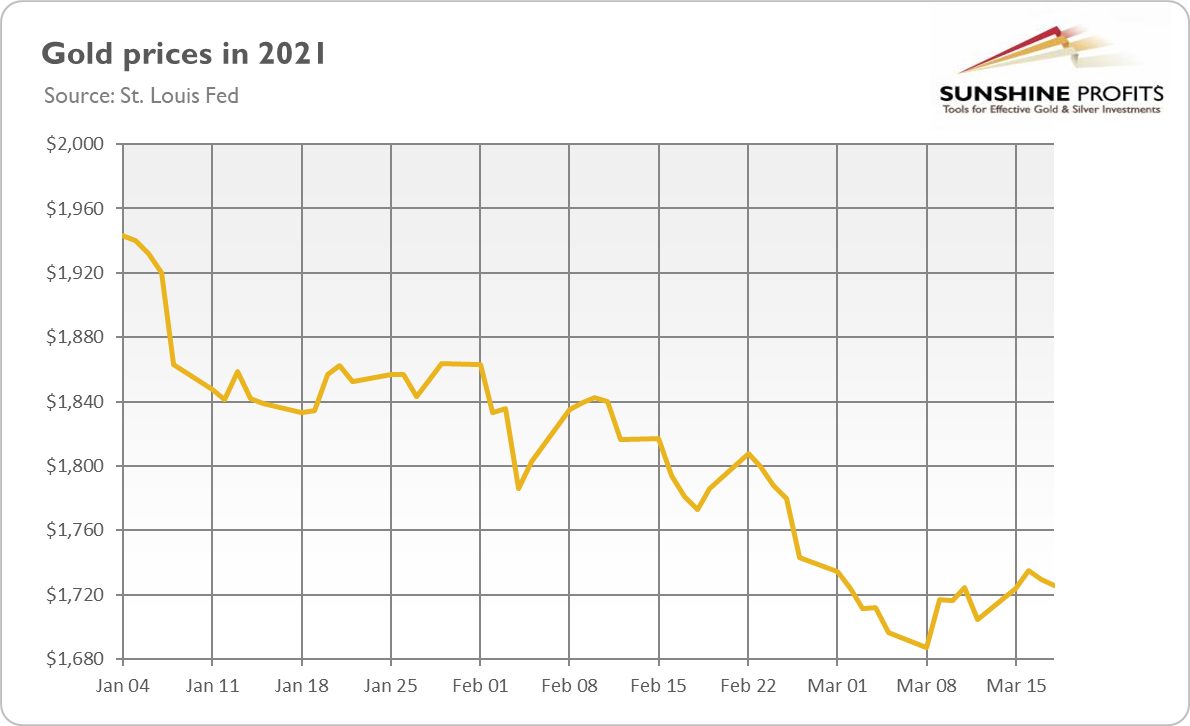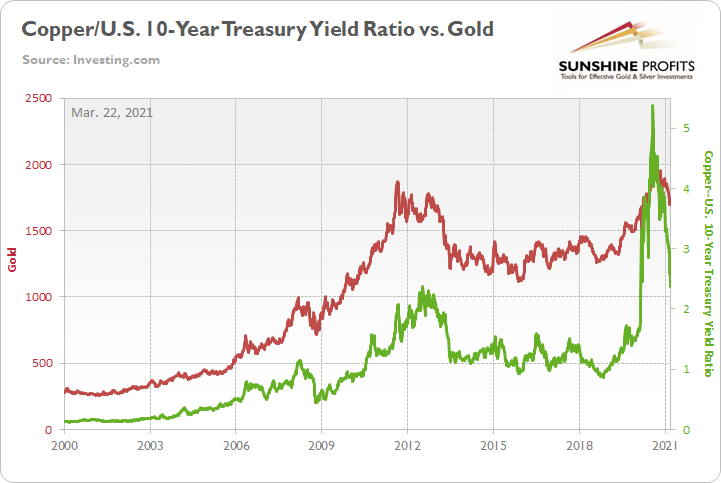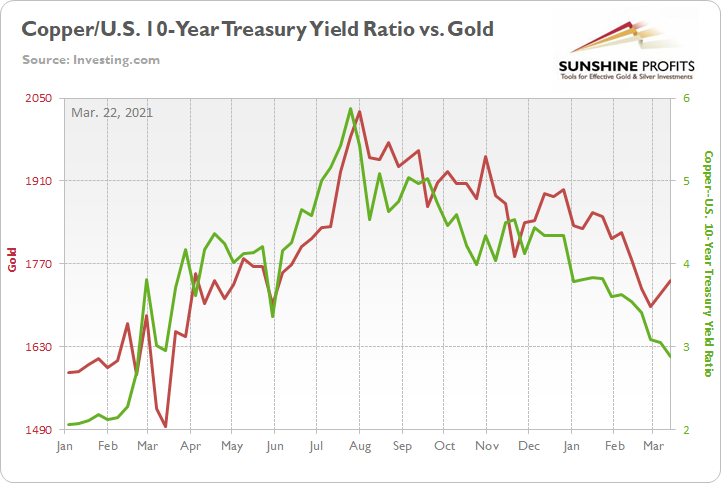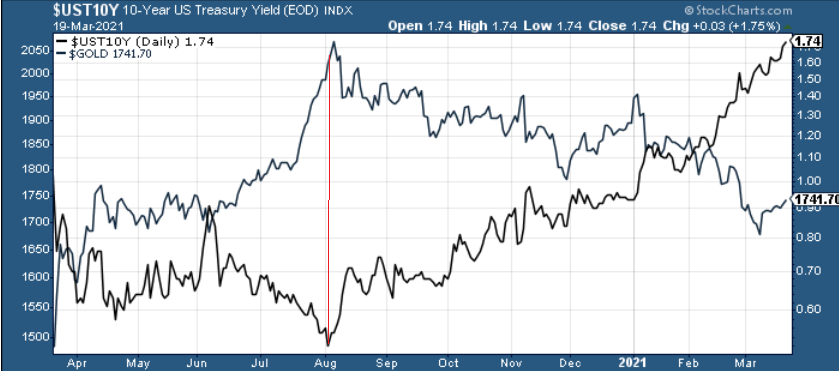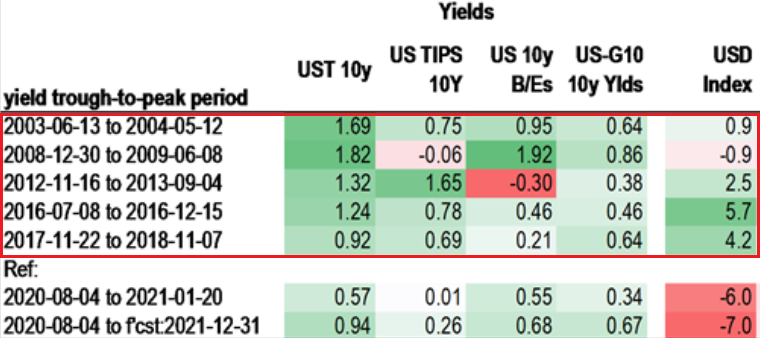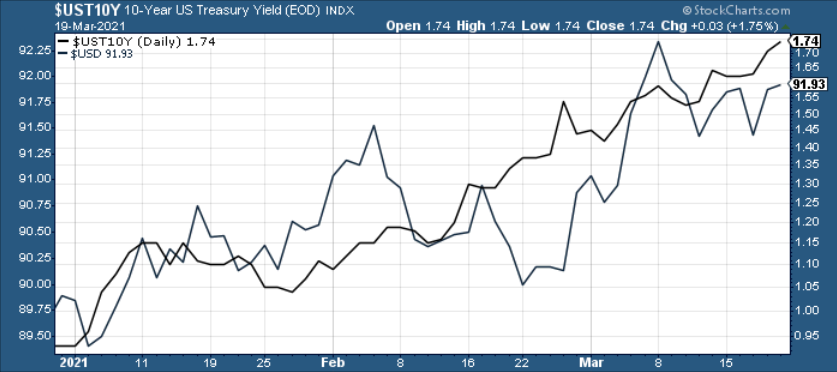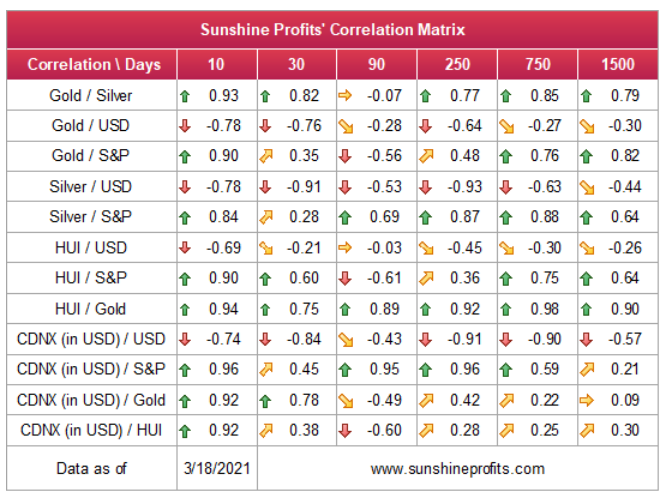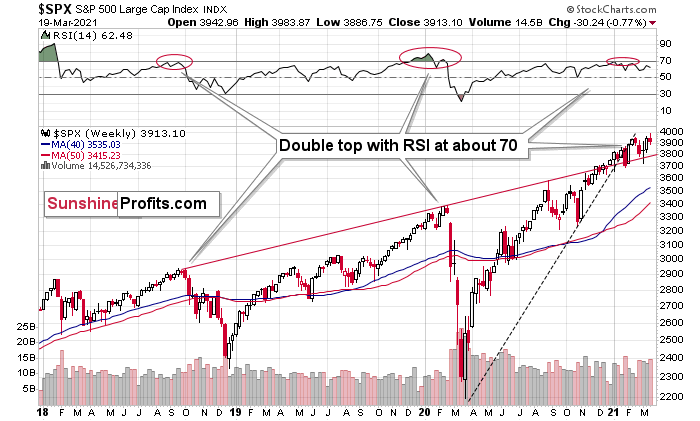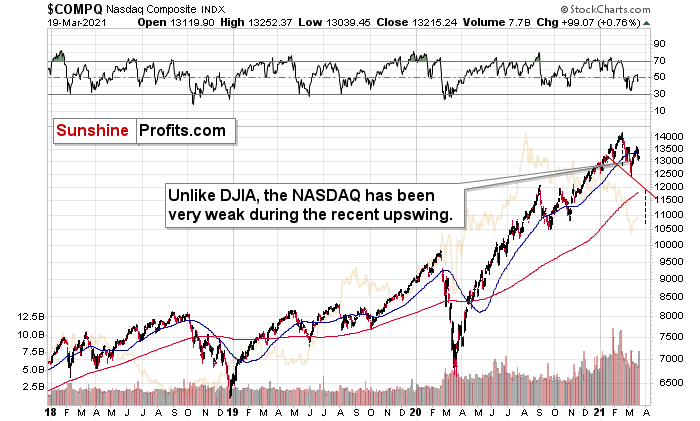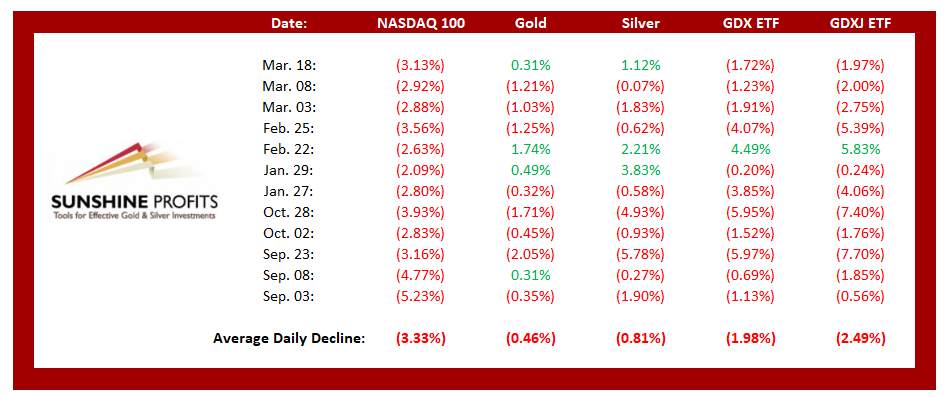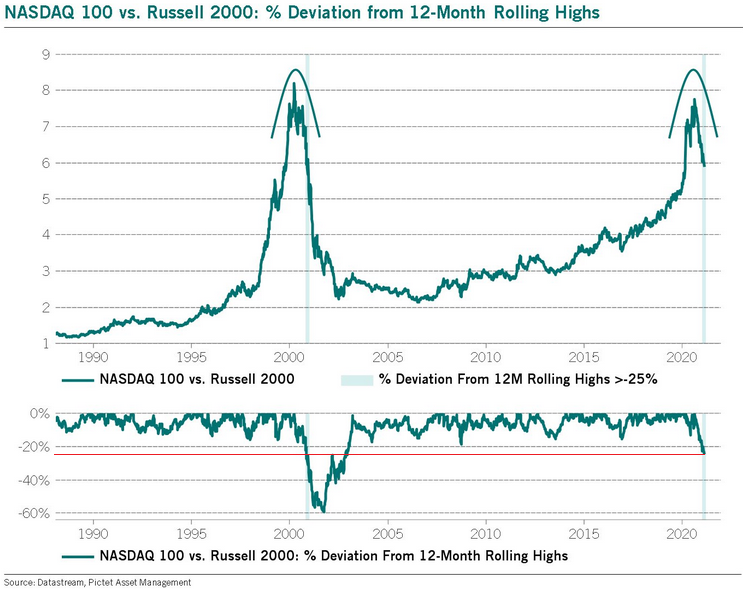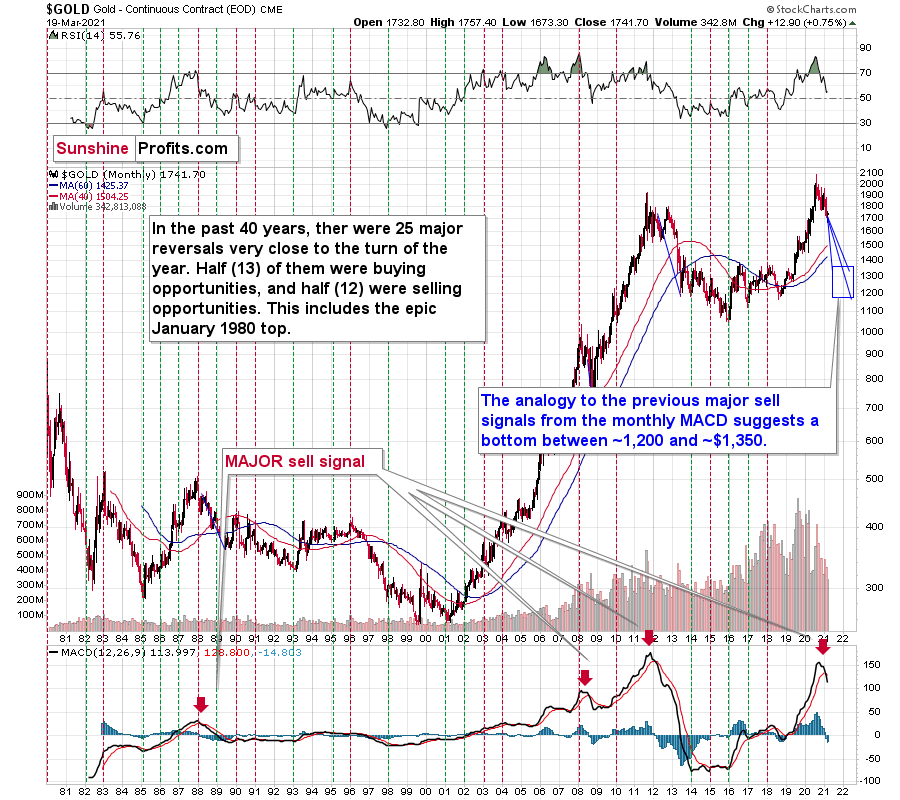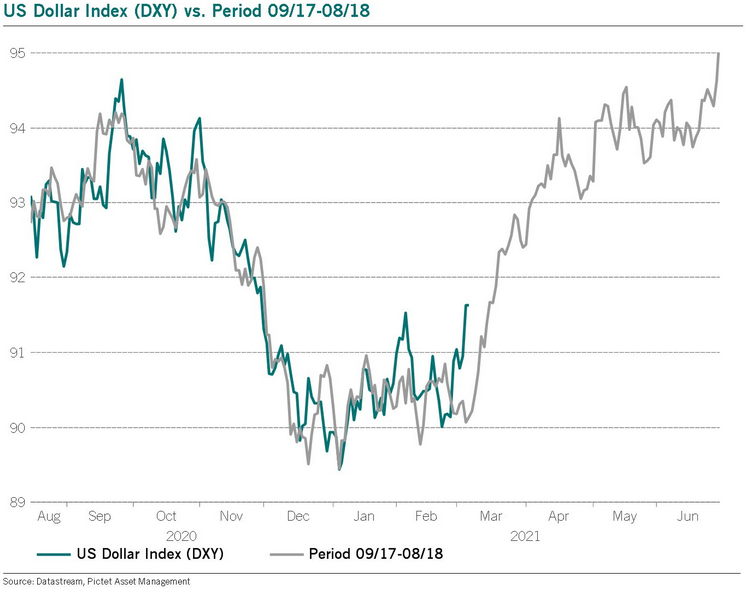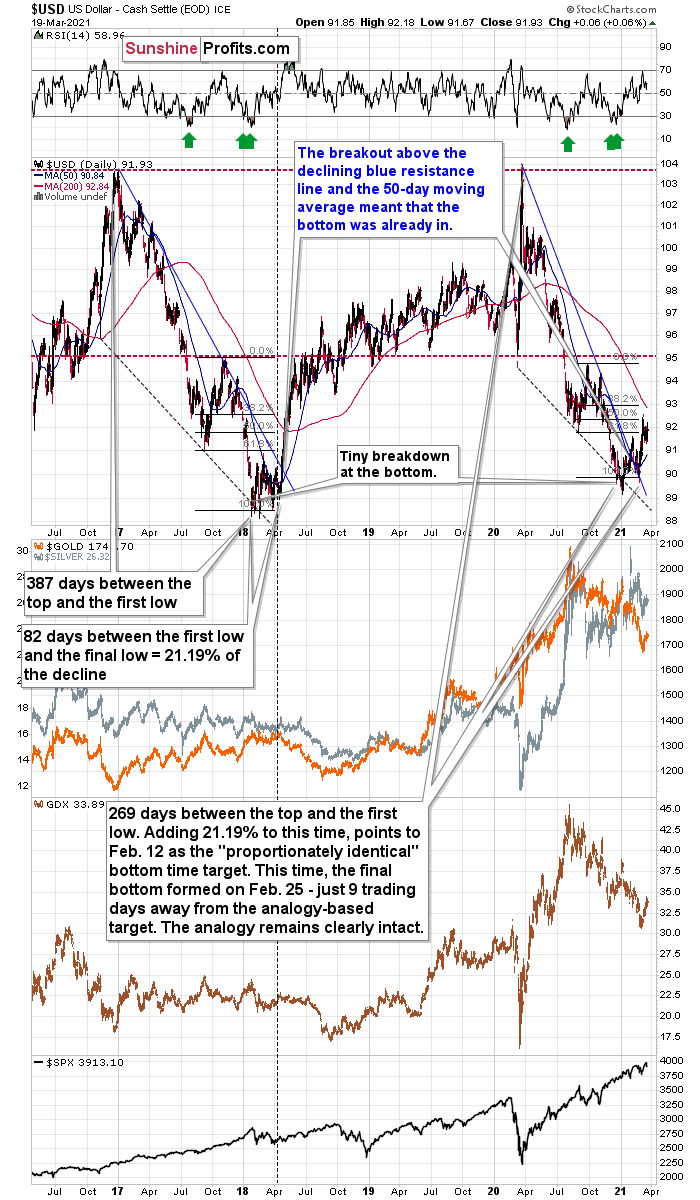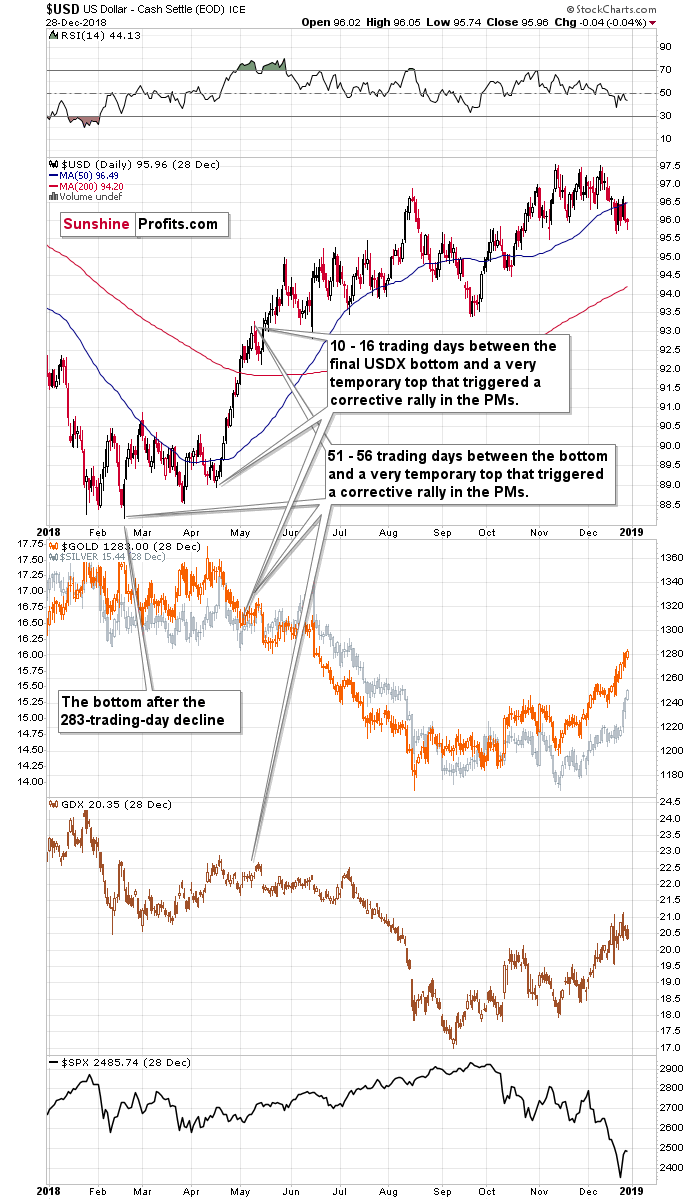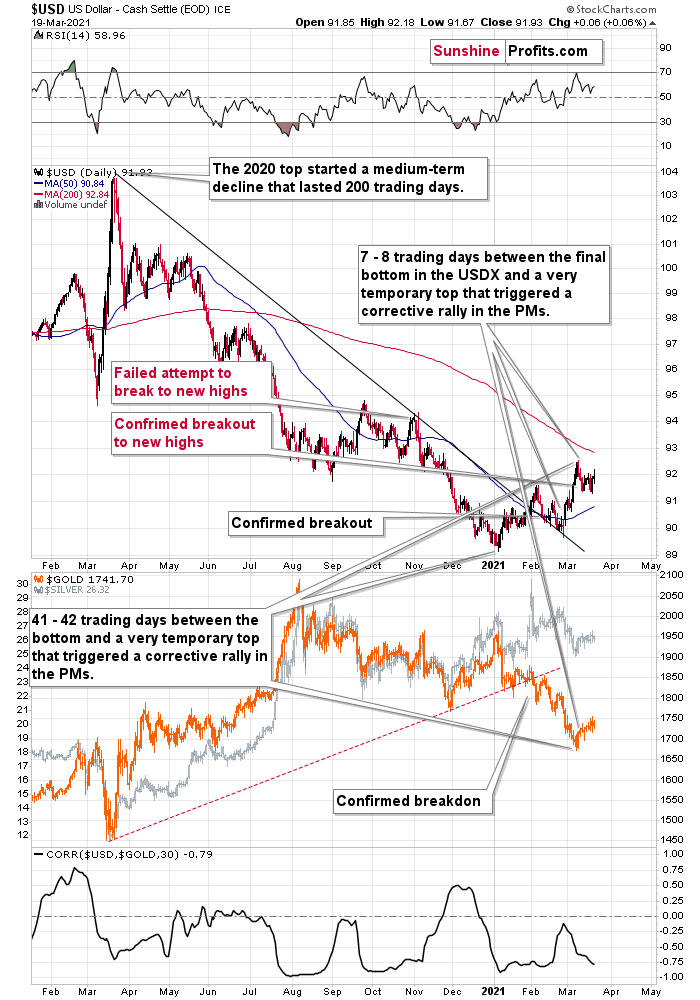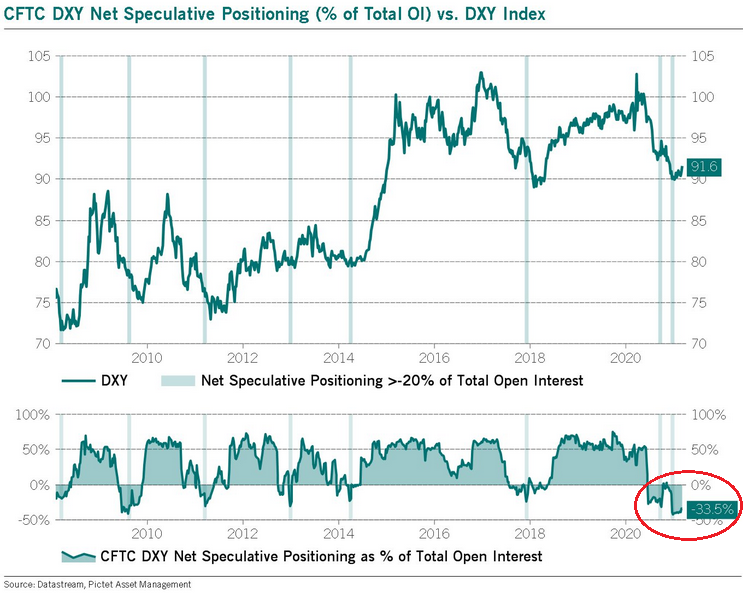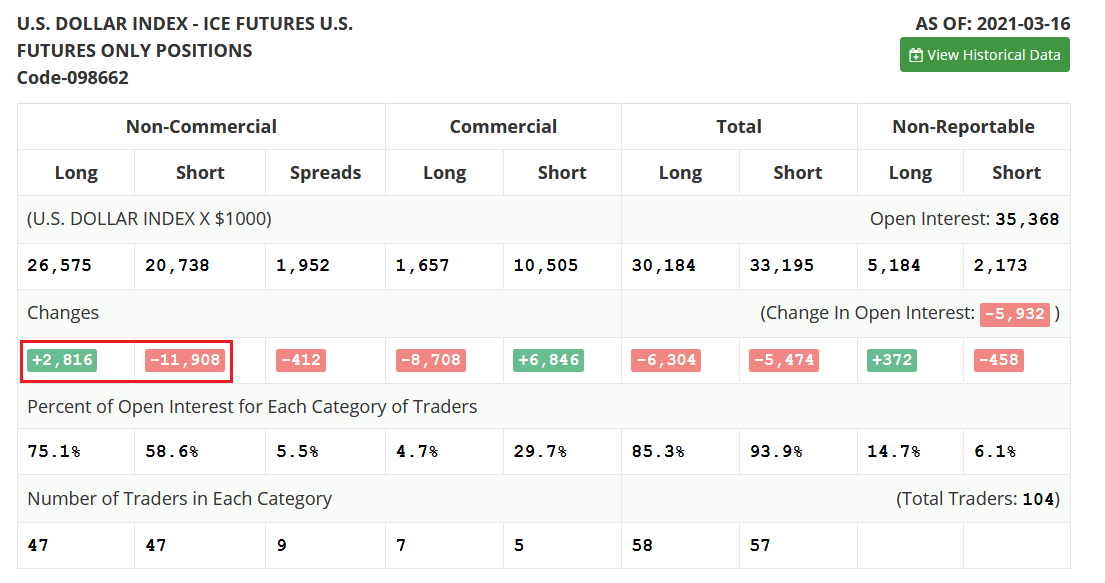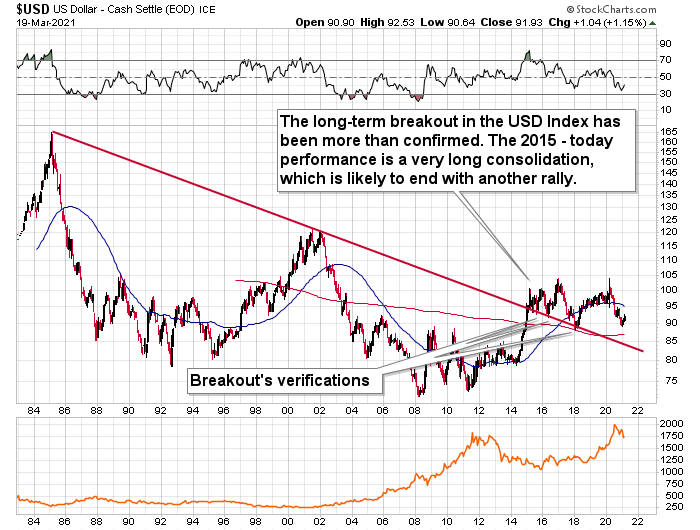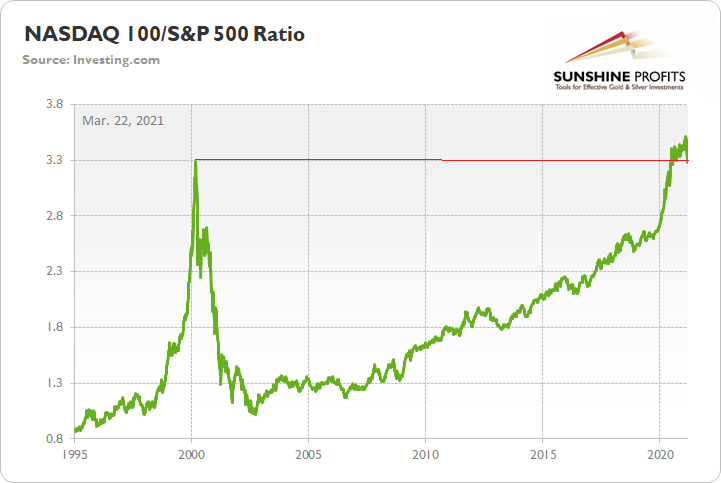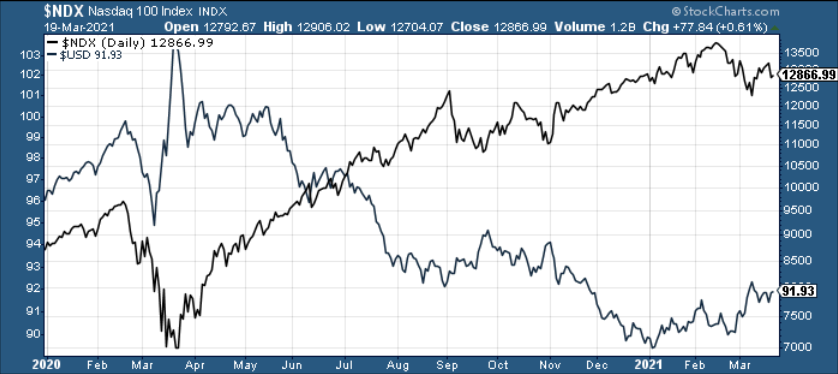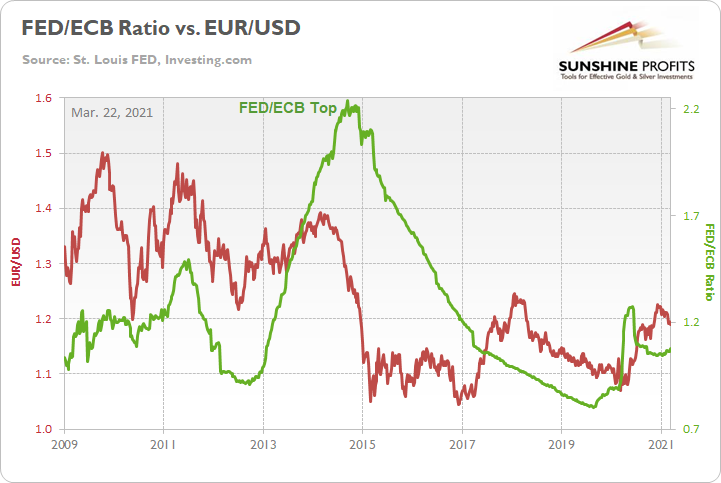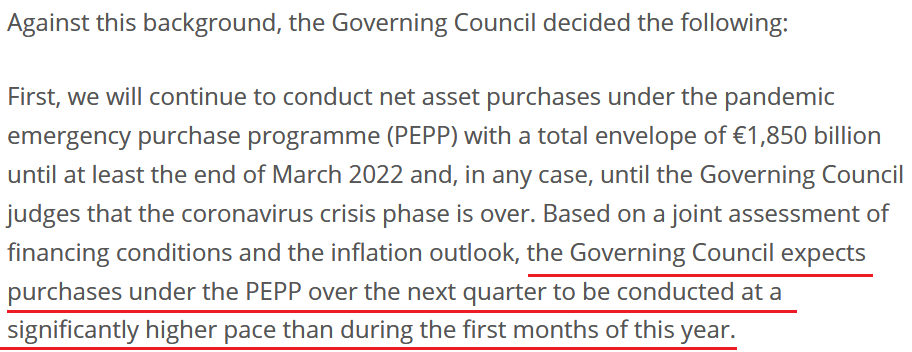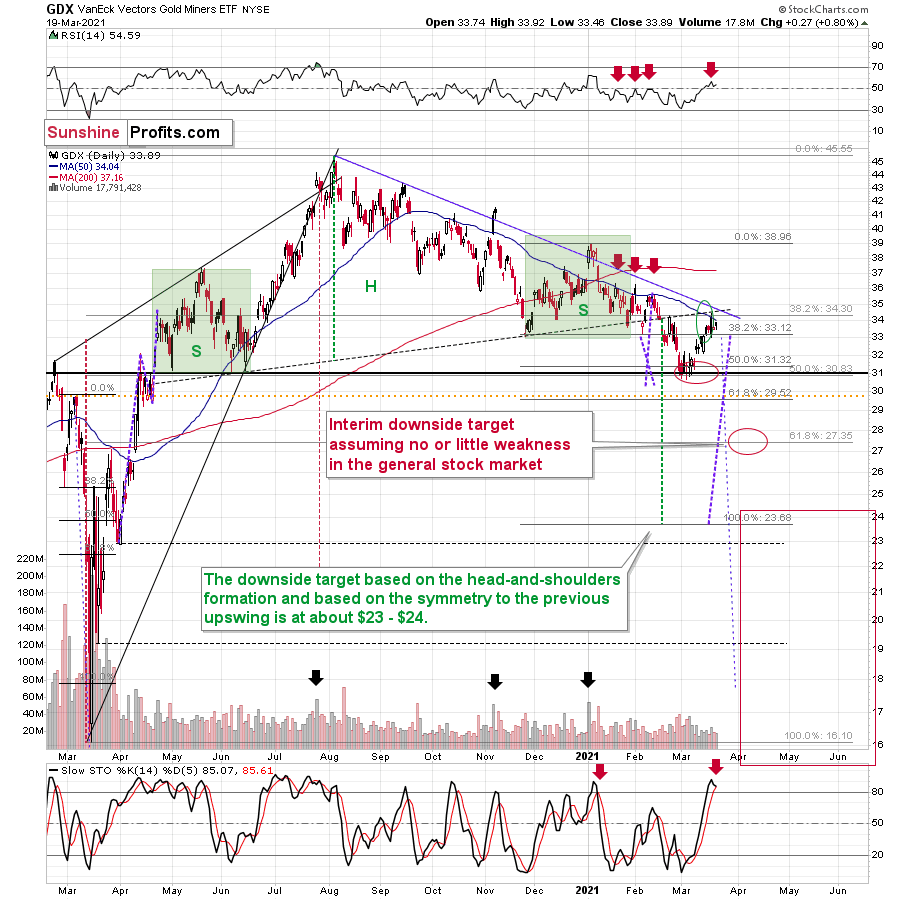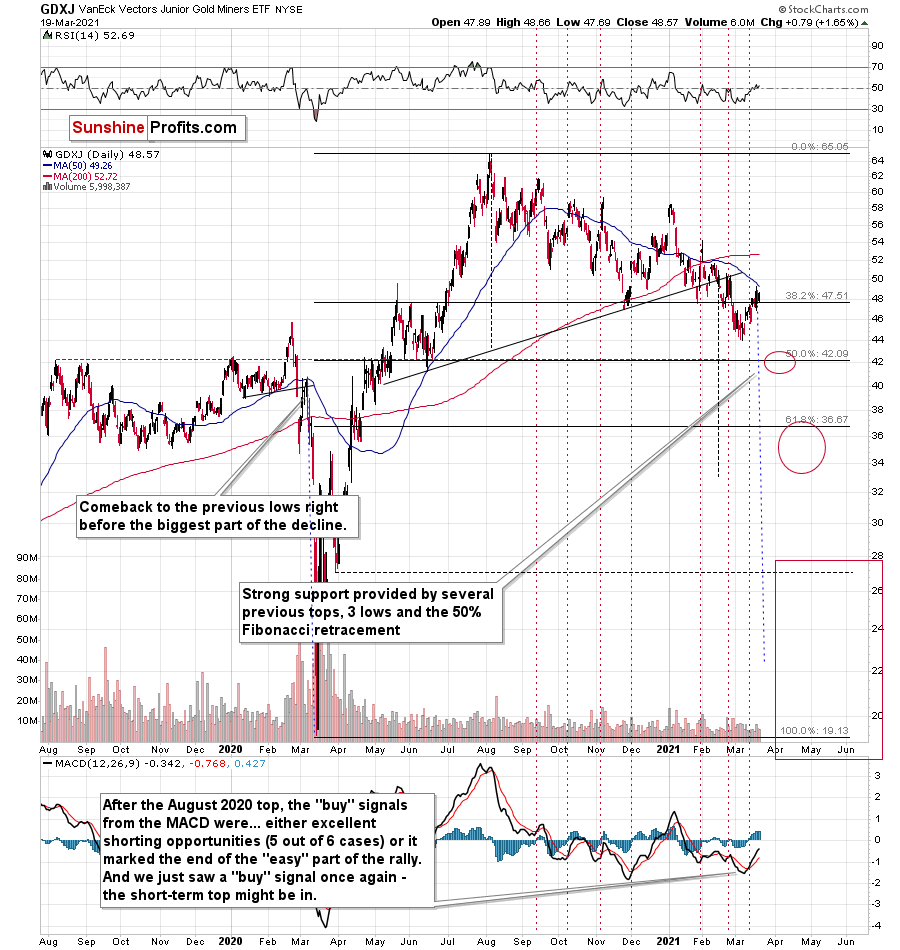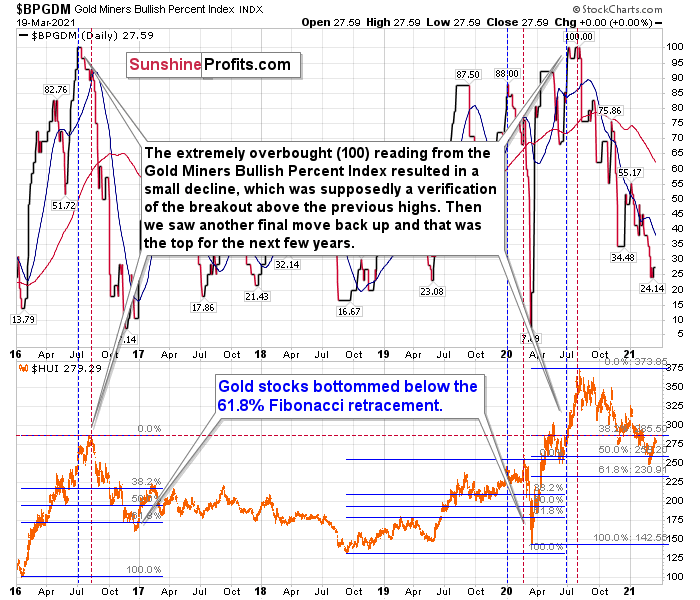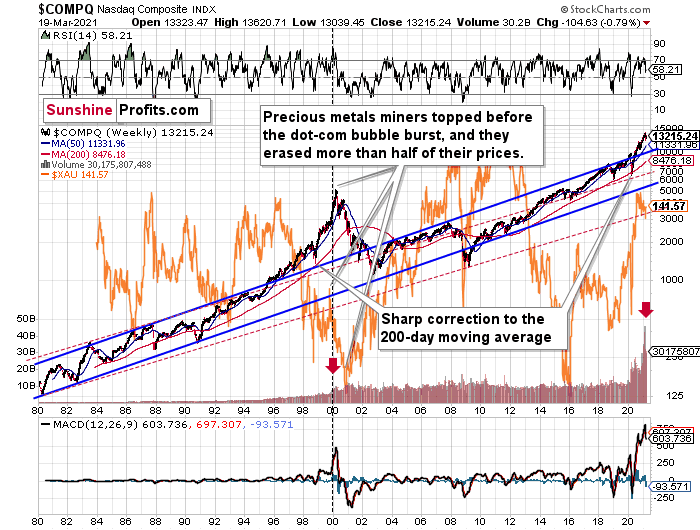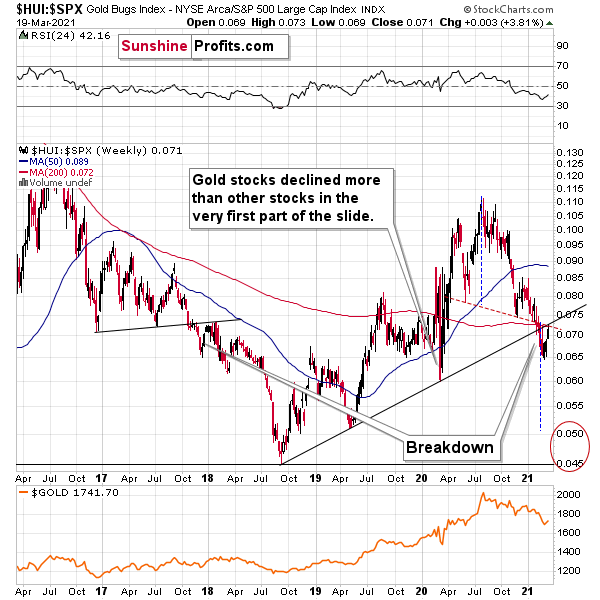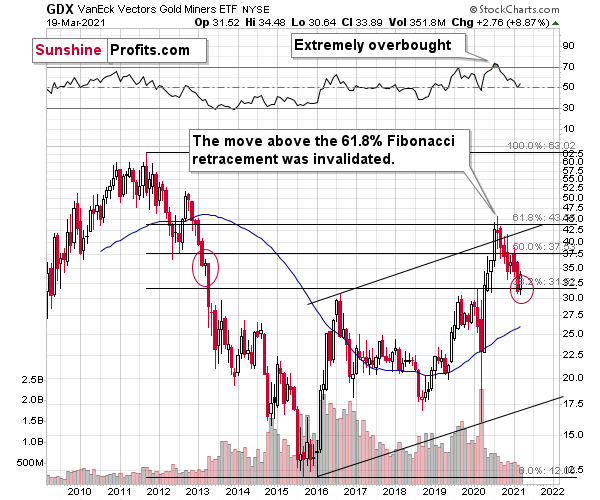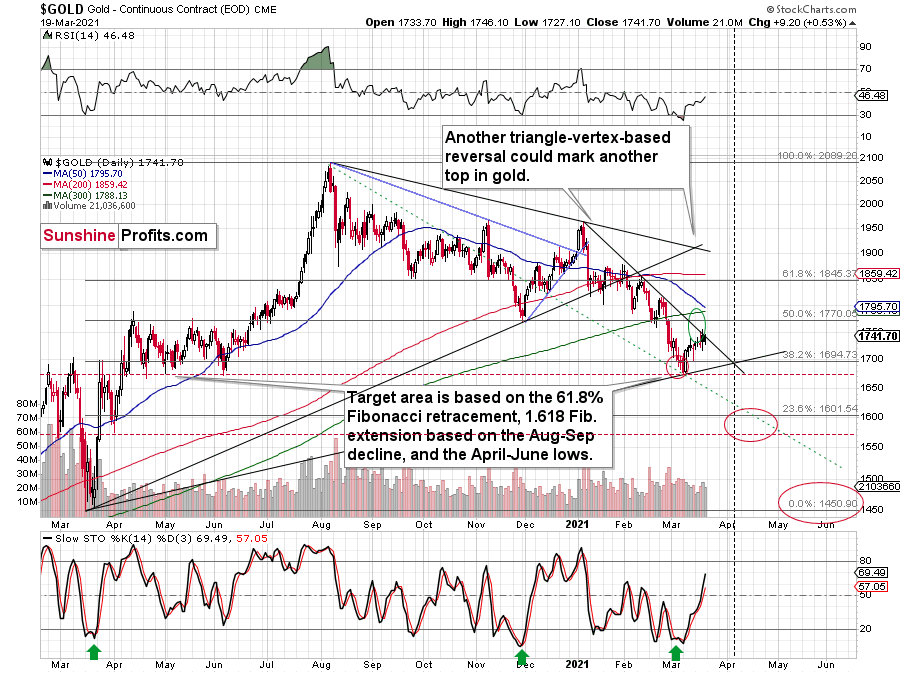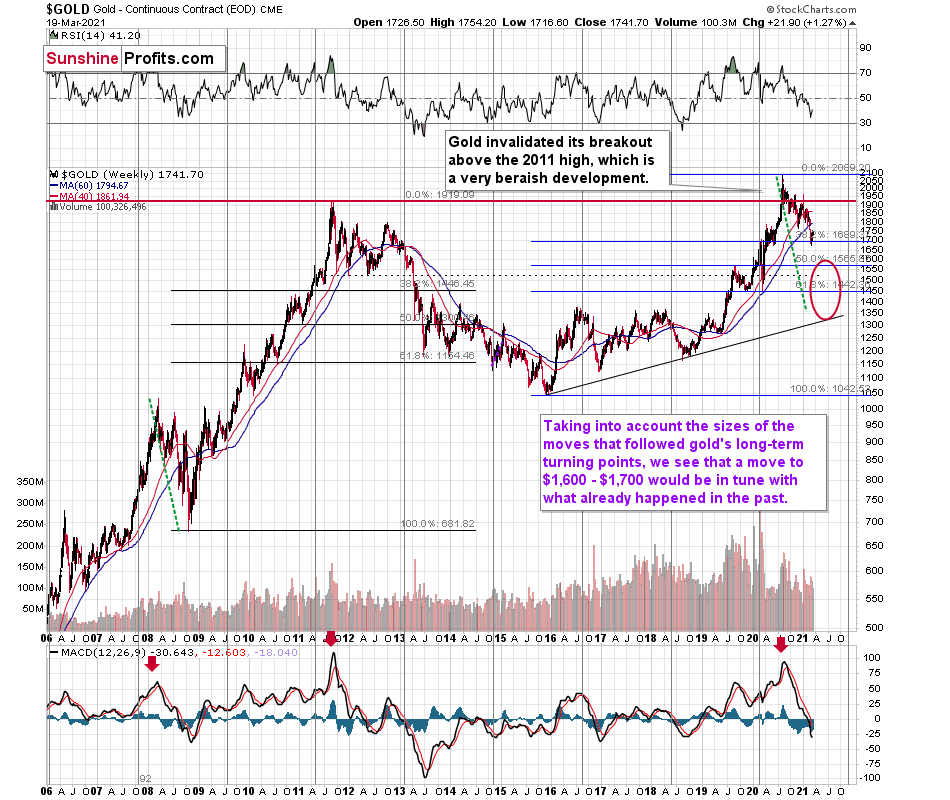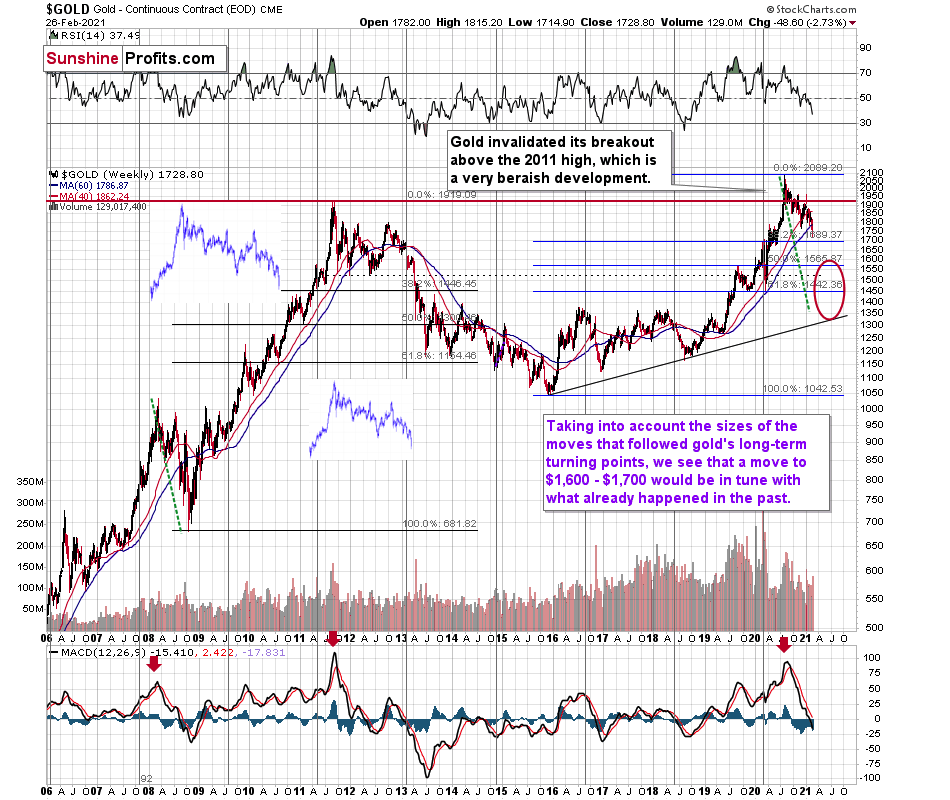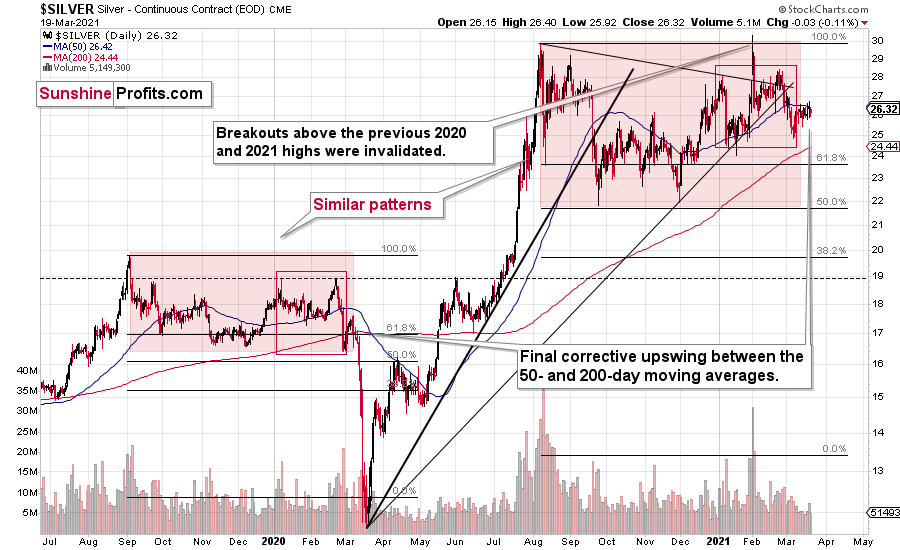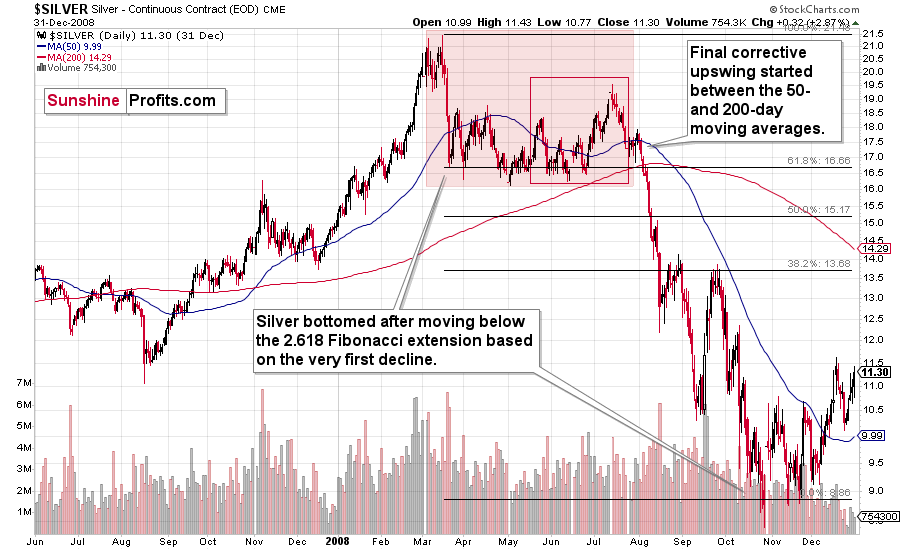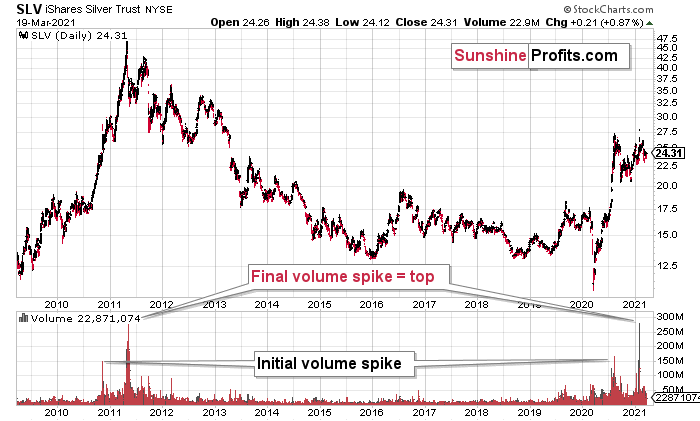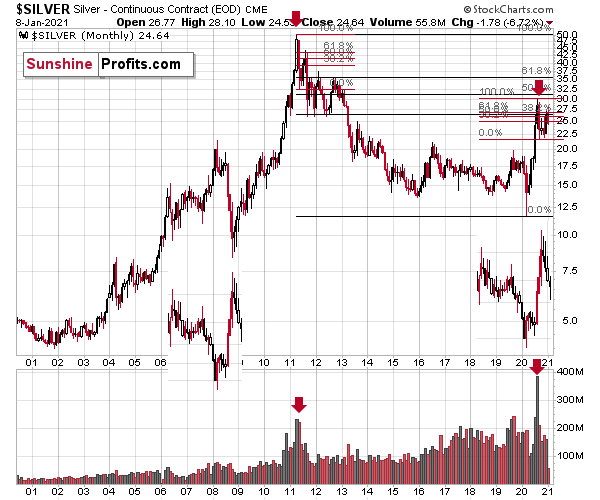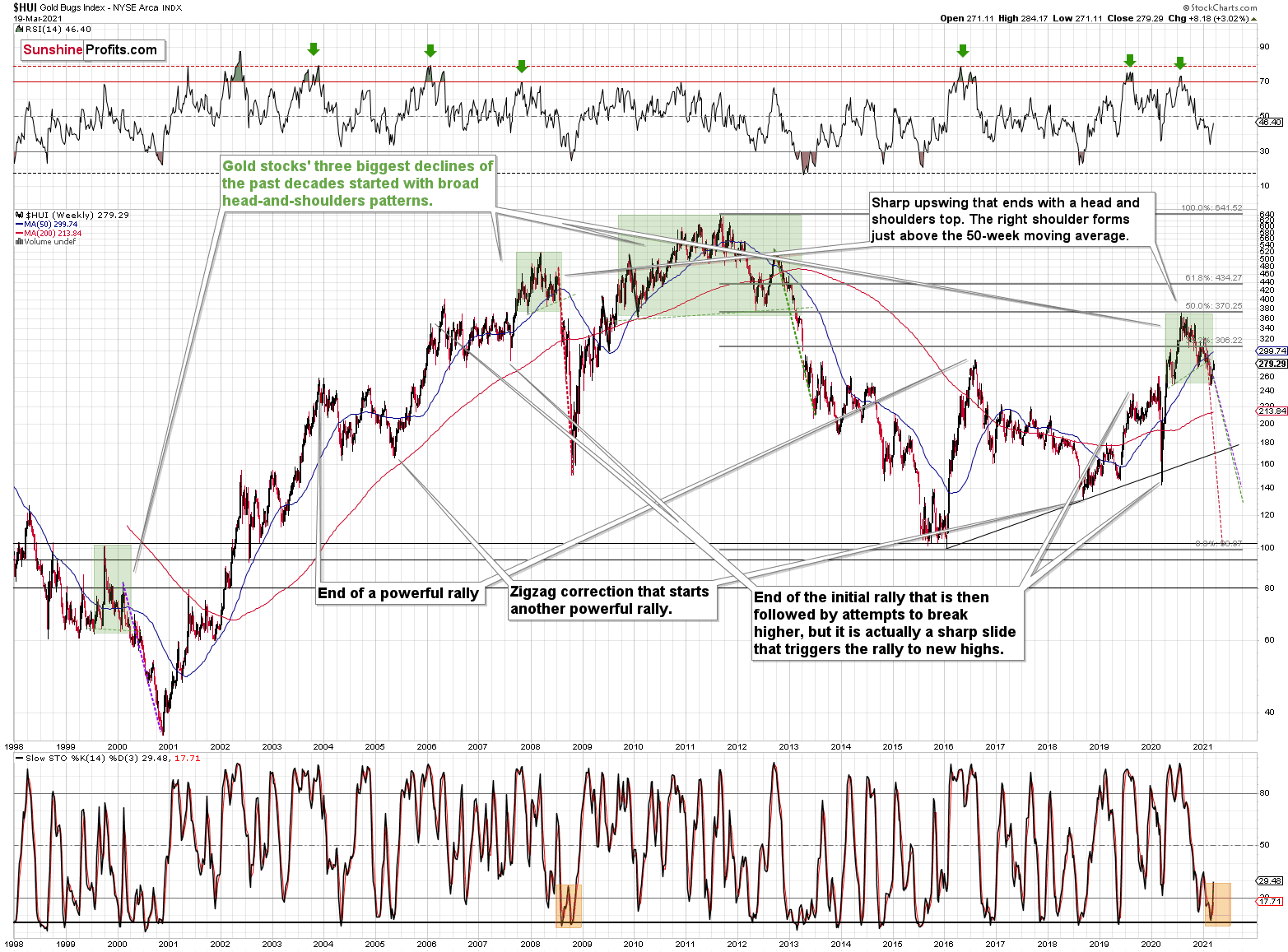Briefly: gold and the rest of the precious metals market are likely to decline in the next several weeks/months and then start another powerful rally. Gold’s strong bullish reversal/rally despite the USD Index’s continuous strength will likely be the signal that confirms that the bottom is in.
Welcome to this week's Gold Investment Update. Predicated on last week’s price moves, our most recently featured outlook remains the same as the price moves align with our expectations. On that account, there are parts of the previous analysis that didn’t change at all in the earlier days, which will be written in italics.
To begin, let’s discuss the fundamental news that hit the market last week, namely, Powell’s recent press conference.
In short, the conference had a dovish vibe to it, but Powell downplayed the rally in bond yields. So, although the Fed’s more tolerant approach to inflation is fundamentally positive for the price of gold, the yellow metal may continue its bearish trend in the short-term.
Our general reading is that the Fed Chair sounded like a dove. First of all, he emphasized several times that the jump in inflation this year will be only transient, resulting from the base effects and rebound in spending as the economy continues to reopen. And Powell explicitly stated that the U.S. central bank will not react to this rise in consumer prices (emphasis added):
Over the next few months, 12-month measures of inflation will move up as the very low readings from March and April of last year fall out of the calculation. Beyond these base effects, we could also see upward pressure on prices if spending rebounds quickly as the economy continues to reopen, particularly if supply bottlenecks limit how quickly production can respond in the near term. However, these one-time increases in prices are likely to have only transient effects on inflation (…) I would note that a transitory rise in inflation above 2 percent, as seems likely to occur this year, would not meet this standard [i.e., the Fed’s goals of maximum employment and stable prices].
Second, Powell also pointed out that we are still far, far away from reaching the Fed’s employment and inflation goals. So, investors shouldn’t expect any hikes in the short-term interest rates or any taper tantrum anytime soon. He was very clear on that, saying that it’s not yet time to start talking about tapering, and that the Fed will announce well in advance any decision to taper its quantitative easing program. Indeed, in a response to the question “is it time to start talking about talking about tapering yet”, he said:
Not yet. So, as you pointed out, we’ve said that we would continue asset purchases at this pace, until we see substantial further progress. And that's actual progress, not forecast progress. (…) We also understand that we will want to provide as much advance notice of any potential taper as possible. So when we see that we’re on track, when we see actual data coming in that suggests that we're on track to perhaps achieve substantial further progress, then we'll say so. And we'll say so well in advance of any decision to actually taper.
Third, the Fed Chair reiterated a few times that the Fed changed its approach and it will not react to the forecast progress, but only to the actual progress, stating that
the fundamental change in in our framework is that we’re not going to act preemptively based on forecasts for the most part. And we’re going to wait to see actual data (…) And we’re committed to maintaining that patiently accommodative stance until the job is well and truly done.
It makes some sense, of course, but it also increases the risk that the Fed’s response to rising inflation will be delayed. The same stance was adopted in the 1970s, when the central bankers believed that they would have plenty of time to react to any dangerous increases in consumer prices. But such an approach resulted in inflation getting out of control, leading to great stagflation. Gold shined then.
What does this all mean for the gold prices? Well, Powell’s latest remarks were dovish, which should support the yellow metal. But, as the chart below shows, we don’t see such a support reflected in the gold prices (London P.M. Fix).
Part of the problem is that the bond yields continued to rise, after a short pullback amid the FOMC statement, exerting further downward pressure on the gold prices. A related issue here is that although Powell sounded generally dovish, he expressed a relaxed view on the current rally in the interest rates. Indeed, when replying to a question on the bond selloff, Powell just said that “we think the stance of our monetary policy remains appropriate”. So, his comments imply that the bond yields have room to move further up in the near-term, thus hurting the price of gold.
However, there is certainly a level of interest rates that would be uncomfortable for the Fed (and Treasury), forcing it to intervene more decisively in the financial markets. And we can be not so far from this level. What’s more, given the rising inflation and inflation expectations, the real interest rates should rise at a slower pace than the nominal yields, or they can actually fall, supporting the gold prices.
If the threshold is at about 3% in case of the 10-year rates, we can expect gold to decline by hundreds of dollars before finding bottom. It seems useful to quote my March 18 reply to the following question from a reader:
Q: I’m not sure if you are tracking this or not, but since the gold peak in August 2020, gold has dropped $3.15 per each one basis point increase in the 10-year yield. If this continues, and the Fed starts YCC at a 10-year yield of 2%, then the trough in the price of gold will be circa $1624. As such, $1350 - $1500 gold might just be a bridge too far.
A: That’s a very interesting observation, thank you. There are two things that I’d like to say here:
- The Fed might not start the YCC program (Operation Twist 3.0) for longer, if stocks don’t plunge profoundly. This would confirm my previous points, when I was writing that I expect PMs and stocks to decline together during the first part of stocks’ decline (exactly what happened after the 1929 top and after the tech bubble burst). This might happen with yields closer to 3%. If that takes place, it would imply – based on your calculations – a bottom about $315 lower than $1,624, meaning at about $1,309.
- Your calculations are based on average movement, and my targets are based on the extremes that gold might reach during the emotional slide. Gold and yields go together, but it’s not a perfect alignment. For instance, right now, the yields just moved to new yearly highs, while gold didn’t, because it had previously declined too much too quickly, and it had to correct. In the final part of its decline, gold would be likely to get ahead of itself too and decline more than “it should”.
In my view, based on any of those reasons, gold could bottom close to $1,500, and based on some (even partial) combination of both, it could temporarily move even lower.
Having said that, let’s move to the cross-asset implications that could affect the precious metals in the coming weeks.
Over the medium-to-long-term, the copper/U.S. 10-Year Treasury yield ratio is a leading indicator of gold’s future behavior.
I wrote previously:
When the copper/U.S. 10-Year Treasury yield ratio is rising (meaning that copper prices are rising at a faster pace than the U.S. 10-Year Treasury yield), it usually results in higher gold prices. Conversely, when the copper/U.S. 10-Year Treasury yield ratio is falling (meaning that the U.S. 10-Year Treasury yield is rising at a faster pace than copper prices), it usually results in lower gold prices.
If you analyze the chart below, you can see the close connection:
Peaking and rolling over within days of one another, gold and the copper/U.S. 10-Year Treasury yield ratio have been in a downward spiral since August. But bucking the trend over the last two weeks, the latter has fallen by 8.01%, while the former has risen by 2.54%. However, given the fact that historical divergences are often outliers and not trends (see October below), the yellow metal is likely to follow the ratio lower over the medium term.
Please see below:
Highlighting the bearish relationship, with the U.S. 10-Year Treasury yield surging by more than 87% year-to-date (YTD) and by more than 216% since its August trough, gold topped exactly one day after the U.S. 10-Year Treasury yield bottomed. Thus, despite the short-term relative strength, gold is unlikely to form a lasting bottom until U.S. Treasury yields begin to plateau.
The bottom line?
With excess liquidity unnerving the bond market, higher U.S. Treasury yields remains the path of least resistance. And if the trend continues, history implies that gold’s divergence from the copper/U.S. 10-Year Treasury yield ratio is unlikely to persist.
Adding another variable to gold’s bearish equation, the USD Index continues to defy historical precedent. If you analyze the table below, you can see that a bottom and subsequent move higher in the U.S. 10-Year Treasury yield has coincided with a rise in the USD Index 80% of the time since 2003.
And while the USD Index is lower now than it was in August, since the New Year, the greenback has begun to follow the U.S. 10-Year Treasury yield higher.
Furthermore, because the yellow metal exhibits a strong negative correlation with the U.S. dollar, gold’s pain tends to coincide with U.S. dollar gains. As a result, if the USD Index continues its upward momentum, the development will add even more concrete to gold’s wall of worry.
On the flip side, if we extend our time horizon, there are plenty of fundamental reasons why gold is likely to soar in the coming years. However, even the most profound bull markets don’t move up in a straight line, and corrections are inevitable.
As it relates to the precious metals, a significant correction (medium-term downtrend) is already underway. However, the pain is not over, and a severe climax likely awaits.
For context, potential triggers are not always noticeable, and the PMs may collapse on their own or as a result of some random trigger that normally wouldn’t cause any major action. However, a trigger will speed things up and that’s where the S&P 500 comes in:
S&P 500 (SPX) Signals
After another Big Tech tirade shook the S&P 500’s foundation, the U.S. equity benchmark invalidated its breakout to new highs. Moreover, with the weakness occurring near 4,000 – a key psychological level – swift resistance could be an indication of a medium-term top.
Slowly letting the air out of the S&P 500’s balloon, the NASDAQ Composite – which led equities’ rally in 2020 – has become a drastic underperformer. A mile away from new highs, not only has equities’ leadership changed, but the NASDAQ Composite could also be in the early innings of forming a bearish head and shoulders pattern.
Please see below:
For context, the potential H&S pattern is still relatively immature. But if the NASDAQ Composite breaks below ~12,000 (the neck level), a drawdown to ~10,550 or ~10,850 (the mid-2020 lows) could be next in line. Remember, the six largest companies in the NASDAQ Composite – Apple, Microsoft, Amazon, Tesla, Facebook and Alphabet – are also the six largest companies in the S&P 500. Thus, a drawdown of the former will weigh heavily on the latter. Likewise, a potential equity rout is profoundly bearish for the PMs, as silver and the miners will likely be the hardest hit.
For context, if you analyze the table above, you can see that NASDAQ 100 drawdowns of more than 2.00% tend to unnerve the PMs. Moreover, if you exclude silver’s short squeeze on Jan. 29 and the NASDAQ 100’s relatively ‘quiet’ 2.63% drawdown on Feb. 22, bouts of equity volatility significantly impact the PMs (especially the miners).
As further evidence of Big Tech’s influence, the NASDAQ 100/Russell 2000 ratio is doing something unseen since November 2000.
On Mar. 2, I wrote:
The green line at the bottom of the chart above depicts the percentage change in the NASDAQ 100/Russell 2000 ratio. As you can see, only one other time in history has the NASDAQ 100/Russell 2000 ratio declined by 25% or more after hitting a 12-month high. For context, November 2000 was roughly 10 months before the NASDAQ Composite troughed (September 2001). And while timing is extremely difficult, it’s a matter of when, not if, equities suffer a similar fate.
Keep in mind though: a decline in stocks is not required for the PMs to decline. But a break in the former could easily trigger a sell-off in the latter, and if history decides to rhyme again, silver and the miners will be the hardest hit.
Very Long-term MACD Sell Signal for Gold
With February’s monthly close the last piece of the puzzle, the MACD indicator’s sell-signal is now perfectly clear. If you analyze the chart below (at the bottom right), you can see that the MACD line has crossed the signal line from above – a development that preceded significant drawdowns in 2008 and 2011.
Based on gold’s previous performance after the major sell signals from the MACD indicator, one could now expect gold to bottom in the ~$1,200 to ~1,350 range. Given the price moves that we witnessed in 1988, 2008 and 2011, historical precedent implies gold forming a bottom in this range. However, due to the competing impact of several different variables, it’s possible that the yellow metal could receive the key support at a higher level.
For more context, I wrote previously:
Only a shade below the 2011 high, today’s MACD reading is still the second-highest reading in the last 40 years. More importantly though, if you analyze the chart below (the red arrows at the bottom), the last four times the black line cut through the red line from above, a significant drawdown occurred.
Also ominous is that the magnitude of the drawdowns in price tend to coincide with the magnitude of the preceding upswings in MACD. And with today’s reading only surpassed by 2011, a climactic move to the $1,250/$1,450 range isn’t out of the question for gold. The above is based on how low gold had previously declined after similarly important sell signal from the MACD
Now, the month is not over yet, so one might say that it’s too early to consider the sell signal that’s based on monthly closing prices, but it seems that given the level that the MACD had previously reached and the shape of the top in the black line, it makes the situation so similar to 2011/2012 that the sell signal itself is just a cherry on the bearish analytical cake.
Considering the reliability of the MACD indicator as a sell signal for major declines, the reading also implies that gold’s downtrend could last longer and be more severe than originally thought. As a result, $1,500 remains the most likely outcome, with $1,350 still in the cards.
The USD Index (USDX)
Rallying by 0.27% last week, the USD Index is slowly getting its groove back. Despite Jerome Powell’s, Chairman of the U.S. Federal Reserve, ultra-dovish comments talking down the greenback on Mar. 17, the USD Index recouped all of those losses (and then some) over the following two days.
And like a protagonist about to reprise his role for the sequel, the USD Index is in the midst of filming “The Resurgence: Part 2.” If you analyze the chart below, you can see that the shape and duration of the current move mirrors the USD Index’s behavior in 2017-2018. And while history often rhymes, it’s rare for it to rhyme so closely. Likewise, while short-term dips were part of the USD Index’s historical journey, the greenback could be ready to exit its consolidation phase.
Please see below:
Similarly, if you analyze the chart below, you can see that today’s technical patterns mirror those that formed in 2017-2018.
And while this time, it took less than 118 days for the USD Index to move from peak to trough, the size and shape of the 2017-2018 analogue clearly mirrors the 2020-current price action.
In 2017-2018, it also took 82 days for the USDX to form a final bottom (the number of days between the initial bottom and the final bottom) and the duration amounts to 21.19% of the overall timeframe. If we applied a similar timeframe to today’s move, then the USD Index should have bottomed on Feb. 12. It actually bottomed (finally) on Feb. 25, which was just 8 trading days away from the former date. Taking into account the sizes of the moves that preceded the previous declines (they took approximately one year to complete), this is extremely close and an excellent confirmation that the self-similar pattern remains intact.
In addition, as the USDX approached its final bottom in 2017-2018, gold traded sideways. Today, however, gold has been in a downward spiral. From a medium-term perspective, the yellow metal’s behavior is actually more bearish than it was in 2017-2018.
Finally, the USD Index’s breakout above its 50-day moving average (which it still holds today) is exactly what added gasoline to the USDX’s 2018 fire. Case in point: after the 2018 breakout, the USDX surged back to its previous high. Today, that level is roughly 94.5.
Even more revealing, gold’s trepidation alongside the USD Index strength on Mar. 12 adds further validity to the 2017-2018 analogy.
I wrote on Mar. 10:
It’s not true that there were no pullbacks during the 2018 rally. There were, but they were simply too small to be visible from the long-term point of view.
The first notable pullback took place in early May 2018, and it contributed to a corrective upswing in the precious metals market. To be precise, the USD Index declined after rallying for 56 trading days, but gold rallied earlier – 51 trading days after the USD Index’s final bottom. The USDX’s immediate-top formed 16 trading days after its final bottom, and gold’s bottom formed 10 trading days after the USD’s final bottom.
Comparing this to the size of the previous decline in terms of the trading days, it was:
- 51 – 56 trading days / 283 trading days = 18.02% - 19.79%
- 10 – 16 trading days / 283 trading days = 3.53% - 5.65%
Also important, when the USD Index turned a short-term decline into consolidation in mid-2018, what followed? Well, gold’s next move was significantly lower, while the USD Index’s next move was significantly higher.
Please see below:
In addition, if we compare the pairs’ historical price action to their recent price action, it’s nearly a splitting image.
Please see below:
To explain, I wrote on Mar. 10:
Let’s examine the current situation: the preceding decline lasted for 200 trading days and there were 41 – 42 trading days between the final USDX bottom and the short-term reversals in gold and USDX. Comparing this to the final USDX bottom, we get 7 – 8 trading days.
Applying the previous percentages to the length of the most recent medium-term decline in the USD Index provides us with the following:
- 18.02% - 19.79% x 200 trading days = ~36 - ~40 trading days
- 3.53% - 5.65% x 200 trading days = ~7 - ~11 trading days
The above estimation of about 36 – 40 trading days almost perfectly fits the current 41 – 42-day delay, and the estimation of about 7 – 11 trading days almost perfectly fits the current delay of 7 – 8 trading days.
In other words, the analogy to the 2018 performance does not only remain intact – it actually perfectly confirms the validity of the current corrective upswing. Once again, it’s very likely just a pullback, not a big trend reversal.
Also noteworthy, a potentially bearish pattern that I have been monitoring – where the USD Index’s price action from July to October 2020 mirrored the price action from December 2020 to February/March 2021– has officially been broken. With the USD Index’s medium-term breakout trumping the former, the potentially bearish pattern has been invalidated and the USD Index is likely to continue its ascension.
But to what end?
Well, back in 2020, the USD Index attempted to recapture its previous highs. But lacking the upward momentum, the failure was followed by a sharp move lower. Today, however, the USD Index has broken above its previous highs and the greenback verified the breakout by consolidating, moving back toward the previous lows and rising once again. Now, the USD Index is visibly above its previous highs.
Taken together, and given the magnitude of the 2017-2018 upswing, ~94.5 is likely the USD Index’s first stop (the mid-2020 high). In the months to follow, the USDX will likely exceed 100 at some point over the medium- or long term.
Expanding our list of potential upside catalysts, the USD Index still has plenty of other bullets in its chamber. For one, U.S. dollar sentiment is beginning to shift. With short interest hitting an all-time high in late-2020, it was a complete fire sale. Today, however, non-commercial (speculative) traders are singing a different tune.
Please see below:
When analyzing the chart above, notice how oversold periods in 2014 and 2018 – where net speculative position as % of total open interest were extremely negative – preceded sharp USDX rallies? Moreover, because today’s reading is even more extreme, the forthcoming rally could be even bigger.
As further evidence, the latest CoT report reveals that speculators (non-commercial) have actually reduced their USD Index short positions by nearly 12,000 contracts and have increased their long positions by nearly 3,000 contracts (the red box below). As a result, the slightest shift in sentiment could lead the rest of the herd to follow.
Finally, let’s not forget that the USD Index is after a long-term, more-than-confirmed breakout. This means that the long-term trend for the U.S. dollar is up.
As another potential catalyst for a USD Index uprising, the NASDAQ Composite’s underperformance could eventually crack U.S. equities. Seesawing back and forth, the NASDAQ 100/S&P 500 ratio rallied by 0.23% last week. However, if the ratio reverts back to its historical average, we’ll likely witness plenty of fireworks.
To that point, given the USDX’s strong negative correlation with the NASDAQ 100, a reversion to the mean could propel the greenback back to its March highs. Moreover, following a short-term consolidation, the USDX could even exceed those prior highs.
As for the FED/ECB ratio, relative outprinting by the European Central Bank (ECB) remains of critical importance. Last week, the ratio increased by 1.25%, while the EUR/USD declined by 0.41%. However, given that the ratio has declined by more than 15% since May, the EUR/USD still has some catching up to do.
Please see below:
Also foretelling a weaker euro, the ECB announced on Mar. 11 that its weekly PEPP purchases will now “be conducted at a significantly higher pace.”
As a result, with the ECB injecting more liquidity to support an underperforming Eurozone economy, the FED/ECB ratio, and the EUR/USD, should move lower over the medium term. More importantly though, because the EUR/USD accounts for nearly 58% of the movement of the USD Index, EUR/USD pain will be the USDX’s gain.
To explain, I wrote previously:
The top in the FED/ECB total assets ratio preceded the slide in the EUR/USD less than a decade ago and it seems to be preceding the next slide as well. If the USD Index was to repeat its 2014-2015 rally from the recent lows, it would rally to 114. This level is much more realistic than most market participants would agree on.
The Gold Miners
With the miners attempting to reclaim Pride Rock, it won’t be long until the GDX ETF is singing Hakuna Matata.
Rising U.S. Treasury yields? No problem.
A reinvigorated USD Index? Who cares.
But while strength is often viewed through the eyes of the beholder, the GDX ETF is far from being The Lion King. Sure, its bravery in the face of familiar foes is reason for optimism. However, we’ve seen this movie before. While the recent rally may resemble Mufasa, beneath the surface, the GDX ETF’s tepid price action looks a lot like Simba.
If you analyze the chart below, you can see that the GDX ETF moved to the upper level of my initial target range. However, with the Mar. 19 close eliciting a sell signal from the stochastic oscillator (the black and red lines at the bottom section of the chart), a historical reenactment (repeat of the early-2021 performance) could deliver another sharp move lower.
In addition, the shape of the early-January swoon is eerily similar to today’s price action. Case in point: back in January, the GDX ETF enjoyed a material daily rally, consolidated, then sunk like a stone. Because of that, the recent move higher and a few days of back-and-forth trading (consolidation) is nothing to write home about.
To explain, I wrote on Mar. 18:
Mining stocks followed gold higher and they moved to the upper part of my previous target area, but not yet to its upper border. As you may recall, I mentioned the possibility of GDX moving to the $34 - $35 area and my original target for this rally was slightly below $34.
The GDX ETF now encountered the strongest combination of resistance areas, while the Stochastic indicator moved above the 80-level. Technically, the situation is now much more bearish in the GDX ETF chart than it was at the beginning of the year. Back in January, the GDX ETF was only at the declining blue resistance line.
Now, in addition to being very close to the above-mentioned line it’s also at:
- The neck level of the previously broken broad head and shoulders pattern
- The 50-day moving average
- The previous (late-February) highs.
Consequently, it’s highly likely that we’ve either just seen a top or one is close at hand.
But if we’re headed for a GDX ETF cliff, how far could we fall?
Well, while the S&P 500 is a key variable in the equation, there are three reasons why the GDX ETF might form an interim bottom at roughly ~$27.50 (assuming no big decline in the general stock market):
- The GDX ETF previously bottomed at the 38.2% and 50.0% Fibonacci retracement levels. And with the 61.8% level next in line, the GDX ETF is likely to garner similar support.
- The GDX ETFs late-March 2020 high should also elicit buying pressure.
- If we copy the magnitude of the late-February/early-March decline and add it to the early-March bottom, it corresponds with the GDX ETF bottoming at roughly $27.50.
Keep in mind though: the interim downside target is based on the assumption of a steady S&P 500. If the stock market plunges, all bets are off. For context, when the S&P 500 plunged in March 2020, the GDX ETF fell below $17 and it took less than two weeks for it to move as low from $29.67. As a result, U.S. equities have the potential to make the miners’ forthcoming swoon all the more painful.
If gold forms an interim bottom close to $1,600, this could also trigger a corrective upswing in the mining stocks, but it’s too early to say for sure whether that’s going to be the case or not.
Also supporting the potential move, the GDX ETF’s head and shoulders pattern – marked by the shaded green boxes above – signals further weakness ahead.
I wrote previously:
Ever since the mid-September breakdown below the 50-day moving average, the GDX ETF was unable to trigger a substantial and lasting move above this MA. The times when the GDX was able to move above it were also the times when the biggest short-term declines started.
(…)
The most recent move higher only made the similarity of this shoulder portion of the bearish head-and-shoulders pattern to the left shoulder) bigger. This means that when the GDX breaks below the neck level of the pattern in a decisive way, the implications are likely to be extremely bearish for the next several weeks or months.
Turning to the junior gold miners, the GDXJ ETF will likely be the worst performer during the upcoming swoon. Why so? Well, due to its strong correlation with the S&P 500, a swift correction of U.S. equities will likely sink the juniors in the process.
What’s more, erratic signals from the MACD indicator epitomizes the GDXJ ETF’s heightened volatility.
Please see below:
To explain, I wrote on Mar. 12:
The above chart is a big red warning flag for beginner investors. The flag reads: “verify the efficiency of a given tool on a given market, before applying it”.
The bottom part of the above chart features the MACD indicator. Normally, when the indicator line (black) crosses its signal line (red), we have a signal. If it’s moves above the signal line, it’s a buy sign, and if it moves below it, it’s a sell sign.
But.
If one actually looks at what happened after the previous “buy signals” in the recent months, they will see that in 5 out of 6 cases, these “buy signals” practically marked the exact tops, thus being very effective sell signals! In the remaining case, it was a good indication that the easy part of the corrective upswing was over.
I’m not only describing the above due to its educational value, but because we actually saw a “buy signal” from the MACD, which was quite likely really a sell signal.
More importantly though, the MACD indicator is far from a light switch. While false buy signals often precede material drawdowns, the reversals don’t occur overnight. As a result, it’s perfectly normal for the GDXJ ETF to trade sideways or slightly higher for a few days before moving lower. This is what we saw last week
But how low could the GDXJ ETF go?
Well, just like the GDX ETF, the S&P 500 is an important variable. However, absent an equity rout, the juniors could form an interim bottom in the $34 to $36 range and if the stocks show strength, juniors could form the interim bottom higher, close to the $42.5 level. For context, the above-mentioned ranges coincide with the 50% and 61.8% Fibonacci retracement levels and the GDXJ ETF’s previous highs (including the late-March/early-April high in case of the lower target area). Thus, the S&P 500 will likely need to roll over for the weakness to persist beyond these levels.
Some people (especially the permabulls that have been bullish on gold for all of 2021, suffering significant losses – directly and in missed opportunities) will say that the final bottom is already in. And this might very well be the case, but it seems highly unlikely to me. On a side note, please keep in mind that I’m neither a permabull nor a permabear for the precious metals sector, nor have I ever been. Let me emphasize that I’m currently bearish (for the time being), but earlier this month, we went long mining stocks on March 4 and exited this trade on March 11.
Another reason (in addition to the myriads of signals coming not only from mining stocks, but from gold, silver, USD Index, stocks, their ratios, and many fundamental observations) is the situation in the Gold Miners Bullish Percent Index ($BPGDM), which is not yet at the levels that triggered a major reversal in the past. The Index is now back above 27. However, far from a medium-term bottom, the latest reading is still more than 17 points above the 2016 and 2020 lows.
Back in 2016 (after the top), and in March 2020, the buying opportunity didn’t present itself until the $BPGDM was below 10.
Thus, with sentiment still relatively elevated, it will take more negativity for the index to find the true bottom.
The excessive bullishness was present at the 2016 top as well and it didn’t cause the situation to be any less bearish in reality. All markets periodically get ahead of themselves regardless of how bullish the long-term outlook really is. Then, they correct. If the upswing was significant, the correction is also quite often significant.
Please note that back in 2016, there was an additional quick upswing before the slide and this additional upswing had caused the $BPGDM to move up once again for a few days. It then declined once again. We saw something similar also in the middle of 2020. In this case, the move up took the index once again to the 100 level, while in 2016 this wasn’t the case. But still, the similarity remains present.
Back in 2016, when we saw this phenomenon, it was already after the top, and right before the big decline. Based on the decline from above 350 to below 280, we know that a significant decline is definitely taking place.
But has it already run its course?
Well, in 2016 and early 2020, the HUI Index continued to move lower until it declined below the 61.8% Fibonacci retracement level. The emphasis goes on “below” as this retracement might not trigger the final bottom. Case in point: back in 2020, the HUI Index undershot the 61.8% Fibonacci retracement level and gave back nearly all of its prior rally. And using the 2016 and 2020 analogues as anchors, this time around, the HUI Index is likely to decline below 231. In addition, if the current decline is more similar to the 2020 one, the HUI Index could move to 150 or so, especially if it coincides with a significant drawdown of U.S. equities.
Moreover, let’s keep in mind that an unwinding of NASDAQ speculation could deliver a fierce blow to the gold miners. Back in 2000, when the dot-com bubble burst, the NASDAQ lost nearly 80% of its value, while gold miners lost more than 50% of their value.
Please see below:
Right now, the two long-term channels above (the solid blue and red dashed lines) show that the NASDAQ is trading well above both historical trends.
Back in 1998, the NASDAQ’s last hurrah occurred after the index declined to its 200-day moving average (which was also slightly above the upper border of the rising trend channel marked with red dashed lines).
And what happened in the first half of 2020? Well, we saw an identical formation.
The similarity between these two periods is also evident if one looks at the MACD indicator. There has been no other, even remotely similar, situation where this indicator would soar so high.
Furthermore, and because the devil is in the details, the gold miners’ 1999 top actually preceded the 2000 NASDAQ bubble bursting. It’s clear that miners (the XAU Index serves as a proxy) are on the left side of the dashed vertical line, while the tech stock top is on its right side. However, it’s important to note that it was stocks’ slide that exacerbated miners’ decline. Right now, the mining stocks are already declining, and the tech stocks continue to rally. Two decades ago, tech stocks topped about 6 months after miners. This might spoil the party of the tech stock bulls, but miners topped about 6 months ago…
Also supporting the 2000 analogue, today’s volume trends are eerily similar. If you analyze the red arrows on the chart above, you can see that the abnormal spike in the MACD indicator coincided with an abnormal spike in volume. Thus, mounting pressure implies a cataclysmic reversal could be forthcoming.
Interestingly, two decades ago, miners bottomed more or less when the NASDAQ declined to its previous lows, created by the very first slide. We have yet to see the “first slide” this time. But, if the history continues to repeat itself and tech stocks decline sharply and then correct some of the decline, when they finally move lower once again, we might see THE bottom in the mining stocks. Of course, betting on the above scenario based on the XAU-NASDAQ link alone would not be reasonable, but if other factors also confirm this indication, this could really take place.
Either way, the above does a great job at illustrating the kind of link between the general stock market and the precious metals market that I expect to see also this time. PMs and miners declined during the first part of the stocks’ (here: tech stocks) decline, but then they bottomed and rallied despite the continuation of stocks’ freefall.
Even more ominous, the MACD indicator is now eliciting a clear sell signal. And displaying a reading that preceded the dot-com bust in 2000, the NASDAQ Composite – and indirectly, the PMs – continue to sail toward the perfect storm.
As further evidence, the HUI Index/S&P 500 ratio has broken below critical support.
Please see below:
When the line above is rising, it means that the HUI Index is outperforming the S&P 500. When the line above is falling, it means that the S&P 500 is outperforming the HUI Index. If you analyze the right side of the chart, you can see that the ratio has broken below its rising support line. For context, the last time a breakdown of this magnitude occurred, the ratio plunged from late-2017 to late-2018. Thus, the development is profoundly bearish.
For further context, the ratio is mirroring the behavior that we witnessed in early 2018. After breaking below its rising support line, the ratio rallied back to the initial breakdown level (which then became resistance) before suffering a sharp decline. And with two-thirds of the analogue already complete today – with the ratio rallying back to its initial breakdown level (now resistance) last week – a sharp reversal could occur sooner rather than later.
In addition, because last week’s bounce was merely a technical development, the HUI Index’s recent strength is nothing to write home about. What’s more, the early-2018 top in the HUI Index/S&P 500 ratio is precisely when the USD Index began its massive upswing. Thus, with history likely to rhyme again, the outlook for the PMs remains profoundly bearish.
Moreover, please note that the HUI to S&P 500 ratio broke below the neck level (red, dashed line) of a broad head-and-shoulders pattern and it verified this breakdown by moving temporarily back to it. The target for the ratio based on this formation is at about 0.05 (slightly above it). Consequently, if the S&P 500 doesn’t decline at all (it just closed the week at 3913.10), the ratio at 0.05 would imply the HUI Index at about 196. However, if the S&P 500 declined to about 3,200 or so (its late-2020 lows) and the ratio moved to about 0.05, it would imply the HUI Index at about 160 – very close to its 2020 lows.
In conclusion, with the miners’ recent confidence likely to fade, it’s only a matter of time before they show their true colors. With the USD Index raring to go and U.S. Treasury yields seemingly exploding on a daily basis, the PMs recent move higher is akin to swimming against a strengthening current: while they’re making progress, each stroke requires more and more energy. In addition, if a drawdown of U.S. equities enters the equation, the metaphor will be akin to swimming against a tsunami. The bottom line? Long positions in the PMs offers more risk than reward over the next several weeks or so. However, once the medium-term climax is complete, it will be smooth sailing once again.
Also, it’s important to remember that in mid-2020, the GDX ETF invalidated its long-term breakout above the 61.8% Fibonacci retracement level (based on the 2011 to 2016 decline).
Please see below:
To explain, I wrote previously:
When GDX approached its 38.2% Fibonacci retracement, it declined sharply – it was right after the 2016 top. And miners’ inability to move above the 61.8% Fibonacci retracement level and their invalidation of the tiny breakout is a bearish sign. The same goes for miners’ inability to stay above the rising support line – the line that’s parallel to the line based on the 2016 and 2020 lows.
In addition, let’s keep in mind that the similarity to how miners declined in 2013 also remains intact and the red ellipses marked on the above chart show that a short-term pause is a normal part of even the biggest declines. Consequently, the recent corrective upswing doesn’t have to mean much, if anything, from the medium-term point of view.
Gold
While a move to ~$1,770 remains a possibility, it’s not my base case. Because the yellow metal rallied back to its declining resistance line and the USD Index looks more and more like a sleeping giant, a profound reversal could be in the cards.
Please see below:
Destined for devaluation after hitting its triangle-vertex-based reversal point (which I warned about previously; currently marked in blue), gold has been unable to regain its magic ever since. And with the 76.4% Fibonacci retracement (it’s visible as 23.6% Fibonacci retracement level on the above chart as the chart provider doesn’t support the 76.4% retracement and inverting the scale is used as a workaround) (~$1,601) also coinciding with gold’s April 2020 low, it signals the possibility of seeing an interim bottom in the ~$1,575 to $1,600 range.
For context, back in early March, the yellow metal continued to decline after reaching the 61.8% Fibonacci retracement (visible as 38.2% Fibonacci retracement) level, while in contrast, the miners began to consolidate. Gold finally bottomed slightly below the retracement – at its previous lows. This time around, we might witness a similar event. And while the story plays out, the miners’ relative strength should signal the end of the slide (perhaps with gold close to 1,600), while gold will likely garner support sometime thereafter (at $1,575 – $1,580 or so).
Gold is scheduled to collide with another triangle-vertex-based reversal point in early April, which might be the moment when we see another corrective rally, but it’s too early to say so with confidence at this time. We’ll know more as we approach this date, and we know what gold did in the meantime.
Still, given the magnitude of the expected move, the yellow metals’ forthcoming decline will likely occur over a longer duration. As well, the ~$1,575 to $1,600 range is only an interim target. Over the medium term, the yellow metal will likely form a lasting bottom in the ~$1,450 to $1,500 range. Seeing a move even lower is not out of the question, but I don’t see it as the most likely outcome.
Pivoting to the long-term chart, you can also see that the yellow metal has already invalidated the breakout above its 2011 high, which has profoundly bearish implications.
Please see below:
Furthermore, if the 2008 analogue repeats – and a crisis of confidence erupts across U.S. equities – the PMs could move substantially lower. When combining an equity shock with a USD Index resurgence, the yellow metal could bottom at roughly $1,400 (or even ~$1,350). However, $1,450 remains to be the most likely downside target, as it coincides with the 61.8% Fibonacci retracement level and the 2019 and 2020 lows.
For more context, I wrote previously:
If you analyze the red arrow in the lower part of the above chart (the weekly MACD sell signal), today’s pattern is similar not only to what we saw in 2011, but also to what we witnessed in 2008. Thus, if similar events unfold – with the S&P 500 falling and the USD Index rising (both seem likely for the following months, even if these moves don’t start right away) – the yellow metal could plunge to below $1,350 or so. The green dashed line shows what would happen gold price, if it was not decline as much as it did in 2008.
As it relates to the chart below, relative to 2011-2013, today’s price action is a splitting image. For starters, gold invalidated the breakout above its 2011 highs. Invalidations of breakouts are sell signals, and it’s tough to imagine a more profound breakout that could have failed.
Second, if you analyze the two white boxes (on the left side of the chart), the blue lines depict today’s short-term price action relative to 2013. As you can see, the movement is nearly identical. I copied the price performance twice, so that you can more easily see the similarity in terms of both the price and time.
Please note that gold delivered a final corrective rebound from the previous lows (so called dead cat bounce) before suffering its current weakness. And in 2013, the yellow metal did the exact same thing. As a result, the free-fall phase has already begun, and the medium-term trend remains down.
For more context, I wrote previously:
The odd thing about the above chart is that I copied the most recent movement in gold and pasted it above gold’s 2011 – 2013 performance. But – admit it – at first glance, it was clear to you that both price moves were very similar.
And that’s exactly my point. The history tends to rhyme and that’s one of the foundations of the technical analysis in general. Retracements, indicators, cycles, and other techniques are used based on this very foundation – they are just different ways to approach the recurring nature of events.
However, every now and then, the history repeats itself to a much greater degree than is normally the case. In extremely rare cases, we get a direct 1:1 similarity, but in some (still rare, but not as extremely rare) cases we get a similarity where the price is moving proportionately to how it moved previously. That’s called a market’s self-similarity or the fractal nature of the markets. But after taking a brief look at the chart, you probably instinctively knew that since the price moves are so similar this time, then the follow-up action is also likely to be quite similar.
In other words, if something looks like a duck, and quacks like a duck, it’s probably a duck. And it’s likely to do what ducks do.
What did gold do back in 2013 at the end of the self-similar pattern? Saying that it declined is true, but it doesn’t give the full picture - just like saying that the U.S. public debt is not small. Back then, gold truly plunged. And before it plunged, it moved lower in a rather steady manner, with periodic corrections. That’s exactly what we see right now.
Please note that the above chart shows gold’s very long-term turning points (vertical lines) and we see that gold topped a bit after it (not much off given their long-term nature). Based on how gold performed after previous long-term turning points (marked with purple, dashed lines), it seems that a decline to even $1,600 would not be out of ordinary.
Finally, please note the strong sell signal from the MACD indicator in the bottom part of the chart. The only other time when this indicator flashed a sell signal while being so overbought was at the 2011 top. The second most-similar case is the 2008 top.
The above-mentioned self-similarity covers the analogy to the 2011 top, but what about the 2008 performance?
If we take a look at how big the final 2008 decline was, we notice that if gold repeated it (percentage-wise), it would decline to about $1,450. Interestingly, this would mean that gold would move to the 61.8% Fibonacci retracement level based on the entire 2015 – 2020 rally. This is so interesting, because that’s the Fibonacci retracement level that (approximately) ended the 2013 decline.
History tends to rhyme, so perhaps gold is going to decline even more than the simple analogy to the previous turning points indicates. For now, this is relatively unclear, and my target area for gold’s final bottom is quite broad.
Silver
While silver revs its engine hoping to gain investors’ attention, its smooth ride will likely breakdown in the near future. Why so? Because today’s price action mirrors what we witnessed in the second half of 2019 and early 2020 – before silver suffered a sharp decline. If you analyze the shaded rectangle on the left side of the chart below, you can see that silver declined substantially, delivered a short-term corrective upswing and then collapsed.
Luring in unsuspecting bulls by overshooting resistance levels and creating “fakeouts” (instead of breakouts) right before plunging, silver is extremely volatile. As a result, mainstream indicators are often misleading when analyzing the white metal.
Regardless, when #SilverSqueeze gained popularity roughly a month and a half ago, commodity tourists pushed the white metal’s pedal to the metal. But quickly invalidating the move to new highs, silver’s strength didn’t stem from fundamentals or a specific technical pattern, the sudden surge was a function of forum posts and newfound retail interest. However, because silver’s rally was quickly invalidated, the upswing didn’t really break the self-similarity pattern.
With the current corrective upswing playing out between the 50- and 200-day moving averages (the blue and red lines above), silver’s recent strength has coincided with corrective upswings in gold and mining stocks (which allowed us to profitably go long in case of the latter). However, the white metal’s current behavior mirrors what we witnessed ~12 months ago, right before the huge slide.
For more context, I wrote on Mar. 17:
The final corrective upswing of early 2020 took place in very late February and early March, while the two – normal – tops that created the red-line rectangle formed more or less at the turn of the year and in late February. This year, it’s all taking place at almost exactly the same time of the year.
If this self-similar pattern is indeed materializing, then the implications are very bearish, and we can expect a major downturn any day or week now.
Let’s be realistic - so far, the analogy might seem too unclear to be viewed as a reliable base for making a silver forecast.
But what if… What if there was a very similar pattern in the past that also preceded a massive decline? This would greatly increase the reliability of the above self-similarity.
There was indeed such a pattern!
That’s what silver did in 2008 before it declined.
The August 2007 – March 2008 rally (please note the interim top in November 2007 that was followed by a zigzag decline, more or less in the middle of the rally) is similar to the March 2020 – August 2021 rally (please note the interim top in June 2020 that was followed by a zigzag pattern, more or less in the middle of the rally).
Afterwards, we saw a double top in both cases that was followed by a sizable slide. Then silver formed a specific U-shaped broad top, where the final top was below the initial one (exception: in this case the forum-based rally took silver slightly above the previous high, but due to the specific / random nature of the move, it “doesn’t count” as something that invalidates the analogy).
After the top, silver declined, and the final corrective upswing took place approximately between the 50- and 200-day moving averages.
Please note that in both previous (2008 and 2020) cases silver then truly plunged, and it kept on declining until it moved below the 2.618 Fibonacci extension based on the initial downswing. The above charts illustrate that by showing the first decline at the 38.2% retracement (1 / 0.382 = approximately 2.618). Applying the same to the current situation (the initial decline took silver from below $30 to below $24) provides us with the minimum decline target at about $13.50. Will silver really decline as low? In my view, it’s imperative to watch other markets for indications as they might have more reliable targets (for instance gold), but I wouldn’t say that this target (or lower price levels) is out of the question. Of course, that’s just on a temporary basis – silver will likely soar in the following months and years (after this decline).
Before summarizing, please note silver’s tendency to decline sharply in March – that’s what happened in 2008 and 2020. Even if the entire self-similar pattern doesn’t continue, based on this seasonality, silver is likely to decline soon, anyway.
Circling back to the effect of #SilverSqueeze, the SLV ETF’s volume spikes in 2020/2021 were nearly identical to the surges that we witnessed ~10 years ago. If you analyze the chart below, you can see that the massive inflows at the end of 2012 were not the beginning of a medium-term upswing. In fact, they coincided with silver’s final bounce before the white metal suffered a major decline.
Please see below:
To explain, I wrote previously:
If you analyze the volume spikes at the bottom of the chart, 2021 and 2011 are a splitting image. To explain, in 2011, an initial abnormal spike in volume was followed by a second parabolic surge. However, not long after, silver’s bear market began.
SLV-volume-wise, there's only one similar situation from the past - the 2011 top. This is a very bearish analogy as higher prices of the white metal were not seen since that time, but the analogy gets even more bearish. The reason is the "initial warning" volume spike in this ETF. It took place a few months before SLV formed its final top, and we saw the same thing also a few months ago, when silver formed its initial 2020 top.
The history may not repeat itself to the letter, but it tends to be quite similar. And the more two situations are alike, the more likely it is for the follow-up action to be similar as well. And in this case, the implications for the silver price forecast are clearly bearish.
Based on the above chart, it seems that silver is likely to move well above its 2011 highs, but it’s unlikely to do it without another sizable downswing first.
Similarly, silver’s inverse price action also has bearish implications. Nearly identical to the inverted formation that emerged from 2006 to 2009, today’s chart looks eerily similar to its predecessor.
While it’s more of a wild card, the above pattern shows that silver’s 2020 top plots nearly identical to the inverse of the 2006-2009 performance. I copied the 2006 – 2009 performance right below the regular price movement and I inverted it, and I also copied this inverted pattern to the last few years.
The similarity is quite significant. And whenever a given pattern has been repeated, the odds are that it could also repeat in the not-too-distant future. Of course, there is no guarantee for that, but once the same market has reacted in a certain way to a specific greed/fear combination, it can just as well do it again. And these similarity-based techniques work quite often. So, while it’s not strong enough to be viewed as a price-path-discovery technique on its own, it should make one consider some scenarios more closely. In particular, this means that the declines in the prices of silver, gold, and mining stocks could be bigger and take longer than it seems based on other charts and techniques.
The above is also in tune with the implications of the sell signal from the MACD indicator on the monthly gold chart.
The only thing that comes to my mind, which could – realistically – trigger such a prolonged decline would be a major drop in the general stock market. Given what I wrote above, the latter is quite possible, so I’ll be on the lookout for confirmations and invalidations of this scenario.
If history rhymes, silver could be in for a profound decline over the next few months (beyond my initial target). Moreover, the development would increase the duration of a precious metals’ bear market (also beyond my initial forecast).
After all, gold did invalidate its long-term breakout above the 2011 highs and the way gold reacted to a small upswing in the USD Index was truly profound…
Moving on to the HUI Index (a proxy for gold stocks), it’s also flashing red in a very bright way – especially from a medium-term perspective.
If you analyze the bottom-half of the chart below, you can see that the stochastic oscillator’s current reading mirrors the reading from 2008 (marked by the two areas shaded orange). Back then, an initial spike in the stochastic oscillator was followed by a swift move lower for both the indicator and the HUI Index. And because today’s reading is nearly identical, a similar reversal could reemerge in the coming weeks, days, or hours.
For more context, I wrote previously:
The three of the biggest declines in the mining stocks (I’m using the HUI Index as a proxy here), all started with broad, multi-month head-and-shoulders patterns. And now we’re seeing this pattern all over again.
The above picture should make it clear why I was putting “at least” in bold, when describing the targets based on the head-and-shoulders patterns.
In all three cases, the size of the decline exceeded the size of the head of the pattern. This means that the $24 target on the GDX ETF chart is likely conservative.
Can we see gold stocks as low as we saw them last year? Yes.
Can we see gold stocks even lower than at their 2020 lows? Again, yes.
Of course, it’s far from being a sure bet, but the above chart shows that it’s not irrational to expect these kind of price levels before the final bottom is reached.
The dashed lines starting at the 2020 top are copies of sizes of the declines that started from the right shoulder of the previous patterns. If things develop as they did in 2000 and 2012-2013, gold stocks are likely to bottom close to their 2020 high. However, if they develop like in 2008 (which might be the case, given the extremely high participation of the investment public in the stock market and other markets), gold stocks could re-test (or break slightly below) their 2016 low.
I know, I know, this seems too unreal to be true… But wasn’t the same said about silver moving below its 2015 bottom in 2020? And yet, it happened.
While describing gold’s very long-term chart, I wrote that based on gold’s MACD indicator, the situation is also similar to what happened in 2008. The above chart shows some additional similarities. Let’s consider the sizes of moves between the 2004 bottom (one could argue that this is when the several-year-long rally started) and the 2008 top, between the initial 2006 top and the 2008 top, and between the very beginning of the final rally – at the end of the fake sharp downswing and the 2008 top.
I marked all of them with dashed lines and I copied them to the current situation. By “current” I mean what happened recently and in the previous years – to the situations that seemed analogous to the ones described above. For instance, the near-vertical 2020 downswing that was followed by a big rally that ended with a big head-and-shoulders top seems similar to what happened in mid-2007.
As one might expect, these dashed lines don’t point to the same price top. No wonder – the history doesn’t repeat itself to the letter, as the circumstances are not identical.
But…
What is remarkable is that on average, these dashed lines did a great job at approximately (!) pinpointing the end of the entire rally and the start of the next massive move lower. One of these three dashed lines is several months too early, one is several months too late, and one is almost exactly pointing to the 2020 top.
This makes the current situation even more similar to what happened in 2008, which has profoundly bearish implications for the entire precious metals sector. I provided more details of this analogy in the Feb. 17 Gold & Silver Trading Alert (please be sure to read the part about similarities to 2008 in the HUI Index, if you haven’t done so already).
And continuing to rhyme, the gold miners are still following the 2008 analogue (even more than the 2013 analogue). If you analyze the dotted red line above (on the right side of the chart), it shows just how quickly the miners could decline should the 2008 analogue play out in full. However, to fully align with 2008, there is still plenty of room to move lower. There are likely to be very brief corrections along the way, just like there were corrections during the 2008 slide, but overall, it seems that the mining stocks are headed much lower and the buy signal from the stochastic indicator should be viewed as very short-term phenomena only.
As for the role of equities, I wrote previously:
A move of this magnitude most likely requires equities to participate. In 2008 and 2020, the sharp drawdowns in the HUI Index coincided with significant drawdowns of the S&P 500. However, with the words ‘all-time high’ becoming commonplace across U.S. equities, the likelihood of a three-peat remains relatively high.
With that said: how will we know when a medium-term buying opportunity presents itself?
We view price target levels as guidelines and the same goes for the Gold Miners Bullish Percent Index (below 10), but the final confirmation will likely be gold’s strength against the ongoing USDX rally. At many vital bottoms in gold, that’s exactly what happened, including the March bottom.
Turning to cross-asset correlations, gold, silver and the HUI Index’s 10-day correlations have stabilized in a logical manner. Exhibiting positive relationships with the S&P 500 and negative relationships with the U.S. dollar, their behavior is akin to what we see over a 250-day period (a reliable length of time). Similarly, the groups’ 30-day correlations are also trending in sensible directions. As a result, and given the PMs strong negative correlations with the U.S. dollar over the last 10, 30 and 250 days, a forthcoming USD Index uprising will likely hurt the PMs’ performance over the medium term.
For more context, I wrote previously:
Since gold, silver, and mining stocks have been strongly negatively correlated with the USD Index in the medium term, it seems likely that they will be negatively affected by the upcoming sizable USDX upswing.
…Until we see the day where gold reverses or soars despite the U.S. currency’s rally.
If that happens with gold at about $1,700, we’ll have a very good chance that this was the final bottom. If it doesn’t happen at that time, or gold continues to slide despite USD’s pause or decline, we’ll know that gold has further to fall.
Naturally we’ll keep you – our subscribers – informed.
To move forward, how does the GDX downside target compare to gold’s downside target? If, at the same time, gold moves to about $1,700 and miners are already after a ridiculously big drop (to $31-$32 in the GDX ETF, or lower), the binding profit-take exit price of your GDX ETF will become $32.02 (those with higher risk tolerance might lower it to $31.15 or so, but moving it lower seems just too risky).
At this time, the final GDX target (the one that would correspond to gold at $1,500 or so) is still unclear. The $17 - $23 area seems probable, especially if the general stock market slides once again. It’s too early to say with any significant level of certainty. Gold is providing us with a clearer final target, so that’s what we’ll focus on. And most importantly – we’ll focus on gold’s performance relative to the USD Index.
Overview of the Upcoming Part of the Decline
- It seems to me that we are already after the initial bottom and the initial correction. If not, then it seems likely to me that the corrective upswing will be completed within a week. It’s more likely that the next big move lower is already underway, though.
- After miners slide once again in a meaningful and volatile way, but silver doesn’t (and it just declines moderately), I plan to switch from short positions in miners to short positions in silver (this could take another 1-2 weeks to materialize). I plan to exit those short positions when gold shows substantial strength relative to the USD Index, while the latter is still rallying. This might take place with gold close to $1,450 - $1,500 and the entire decline (from above $1,700 to about $1,475) would be likely to take place within 1-12 weeks and I would expect silver to fall hardest in the final part of the move. This moment (when gold performs very strongly against the rallying USD and miners are strong relative to gold – after gold has already declined substantially) is likely to be the best entry point for long-term investments in my view. This might happen with gold close to $1,475, but it’s too early to say with certainty at this time. In other words, the entire decline could take between 1 and 12 weeks, while silver declines particularly fast in the final 1-2 weeks.
- If gold declines even below $1,500 (say, to ~$1350 or so), then it could take another 10 weeks or so for it to bottom, but this is not what I view as a very likely outcome.
- As a confirmation for the above, I will use the (upcoming or perhaps we have already seen it?) top in the general stock market as the starting point for the three-month countdown. The reason is that after the 1929 top, gold miners declined for about three months after the general stock market started to slide. We also saw some confirmations of this theory based on the analogy to 2008. All in all, the precious metals sector would be likely to bottom about three months after the general stock market tops . If the mid-February 2020 top was the final medium-term top, then it seems that we might expect the precious metals sector to bottom in mid-May or close to May’s end.
- The above is based on the information available today and it might change in the following days/weeks.
Letters to the Editor
Q: Would you buy the XAUXAG?
A: (In other words, would I buy the gold to silver ratio given the possibility, and do I think if gold is now going to be stronger than silver). In short, yes, but I think that a directional trade in the mining stocks provides a better risk to reward ratio. As the general stock market is likely to decline, and as the medium-term decline in the precious metals market is likely coming to an end, silver is likely to fall more than gold, thus pushing the gold to silver ratio higher.
Q: I have some money in my retirement 401(k) in cash and would like to boost it a little. Would you advise putting that money in some gold stocks for a longer (not daily or weekly) period of time? If so, should I do it now or wait when the correction in the gold market will be over, like in a few weeks or months? I am not good in investing at all but love your realistic and objective articles and analysis. I would really appreciate if you could find just a moment with a piece of your advice.
A: I think that gold stocks (and silver stocks) will provide a great buying opportunity within the next several weeks (or months). When looking from a very long-term point of view, the current prices are already quite good buying opportunities, but since I think that we are just before another downswing, it’s difficult for me to say whether buying right now is a great thing to do.
I have a long-term approach, I’m patient, and my risk-tolerance is above-average – I’m choosing to not only wait with my purchases of mining stocks for the next several weeks (or months), but I’m actually positioned to profit from the unfolding decline. Whether that’s an appropriate approach for you – I don’t know, because I don’t know the other details of your financial (and non-financial) situation. And even if I knew - I couldn’t provide individual investment advice. What I’m writing here is a general opinion about the market and it’s not directed at any specific reader (that’s the most that I can provide). I hope you (and other readers) will find the above useful.
Summary
To summarize, the PMs’ medium-term decline is well underway, and based on the recent performance of the USD Index, gold and mining stocks, it seems that the corrective upswing is already over (or about to be over). The next big move lower seems to be already underway or about to start.
In addition, because we’re likely entering the “winter” part of the Kondratiev cycle (just like in 1929 and then the 1930s), the outlook for the precious metals’ sector remains particularly bearish during the very first part of the cycle, when cash is king.
The confirmed breakout in the USD Index is yet another confirmation of the bearish outlook for the precious metals market.
After the sell-off (that takes gold to about $1,450 - $1,500), we expect the precious metals to rally significantly. The final part of the decline might take as little as 1-5 weeks, so it's important to stay alert to any changes.
Most importantly, please stay healthy and safe. We made a lot of money last March and it seems that we’re about to make much more on this March decline, but you have to be healthy to enjoy the results.
As always, we'll keep you - our subscribers - informed.
By the way, we’re currently providing you with a possibility to extend your subscription for a year, two years or even three years with a special 20% discount. This discount can be applied right away, without the need to wait for your next renewal – if you choose to secure your premium access and complete the payment upfront. The boring time in the PMs is definitely over and the time to pay close attention to the market is here. Naturally, it’s your capital, and the choice is up to you, but it seems that it might be a good idea to secure more premium access now, while saving 20% at the same time. Our support team will be happy to assist you in the above-described upgrade at preferential terms – if you’d like to proceed, please contact us.
To summarize:
Short-term outlook for the precious metals sector (our opinion on the next 1-6 weeks): Bearish
Medium-term outlook for the precious metals sector (our opinion for the period between 1.5 and 6 months): Bearish initially, then possibly Bullish
Long-term outlook for the precious metals sector (our opinion for the period between 6 and 24 months from now): Bullish
Very long-term outlook for the precious metals sector (our opinion for the period starting 2 years from now): Bullish
As a reminder, Gold Investment Updates are posted approximately once per week. We are usually posting them on Monday, but we can’t promise that it will be the case each week.
Our preferred ways to invest in and to trade gold along with the reasoning can be found in the how to buy gold section. Additionally, our preferred ETFs and ETNs can be found in our Gold & Silver ETF Ranking.
Moreover, Gold & Silver Trading Alerts are posted before or on each trading day (we usually post them before the opening bell, but we don’t promise doing that each day). If there’s anything urgent, we will send you an additional small alert before posting the main one.
Thank you.
Sincerely,
Przemyslaw Radomski, CFA
Founder, Editor-in-chief


